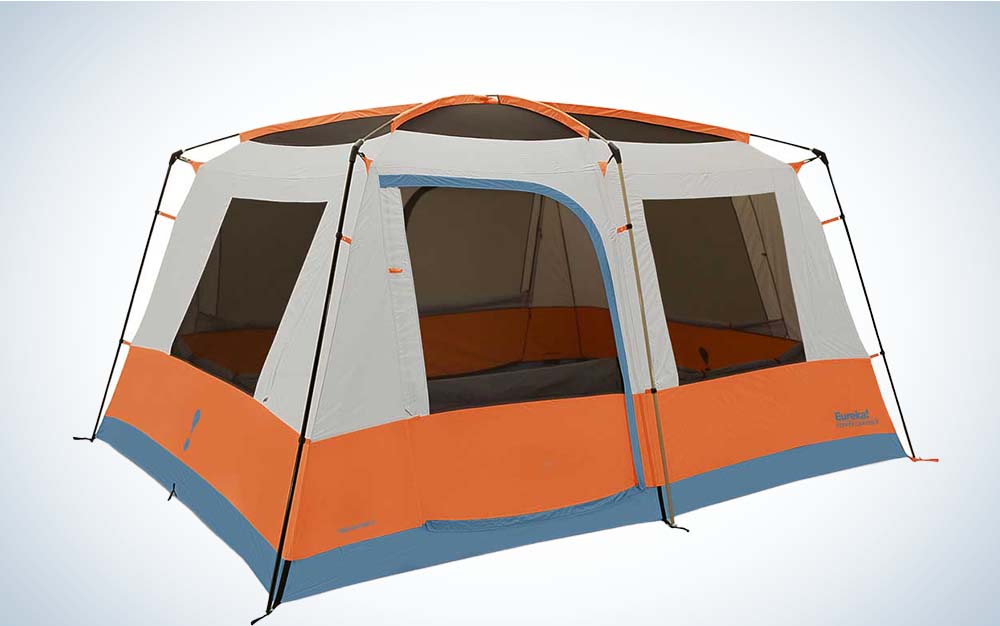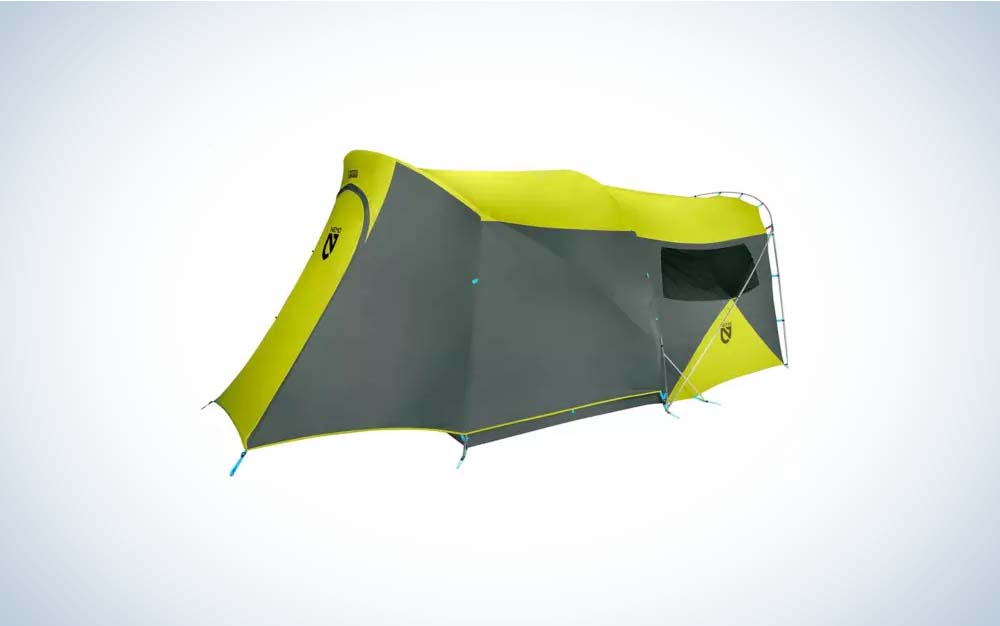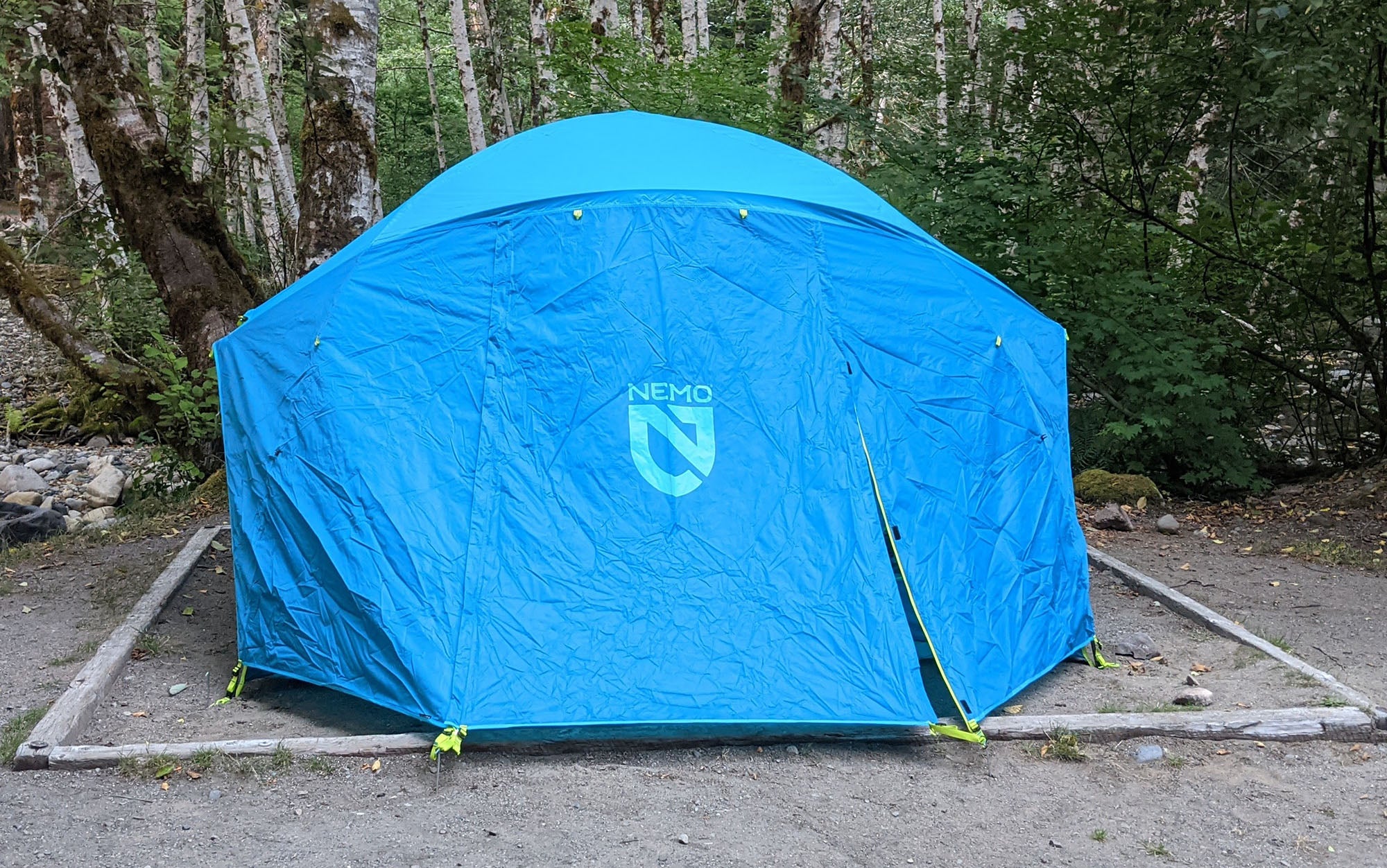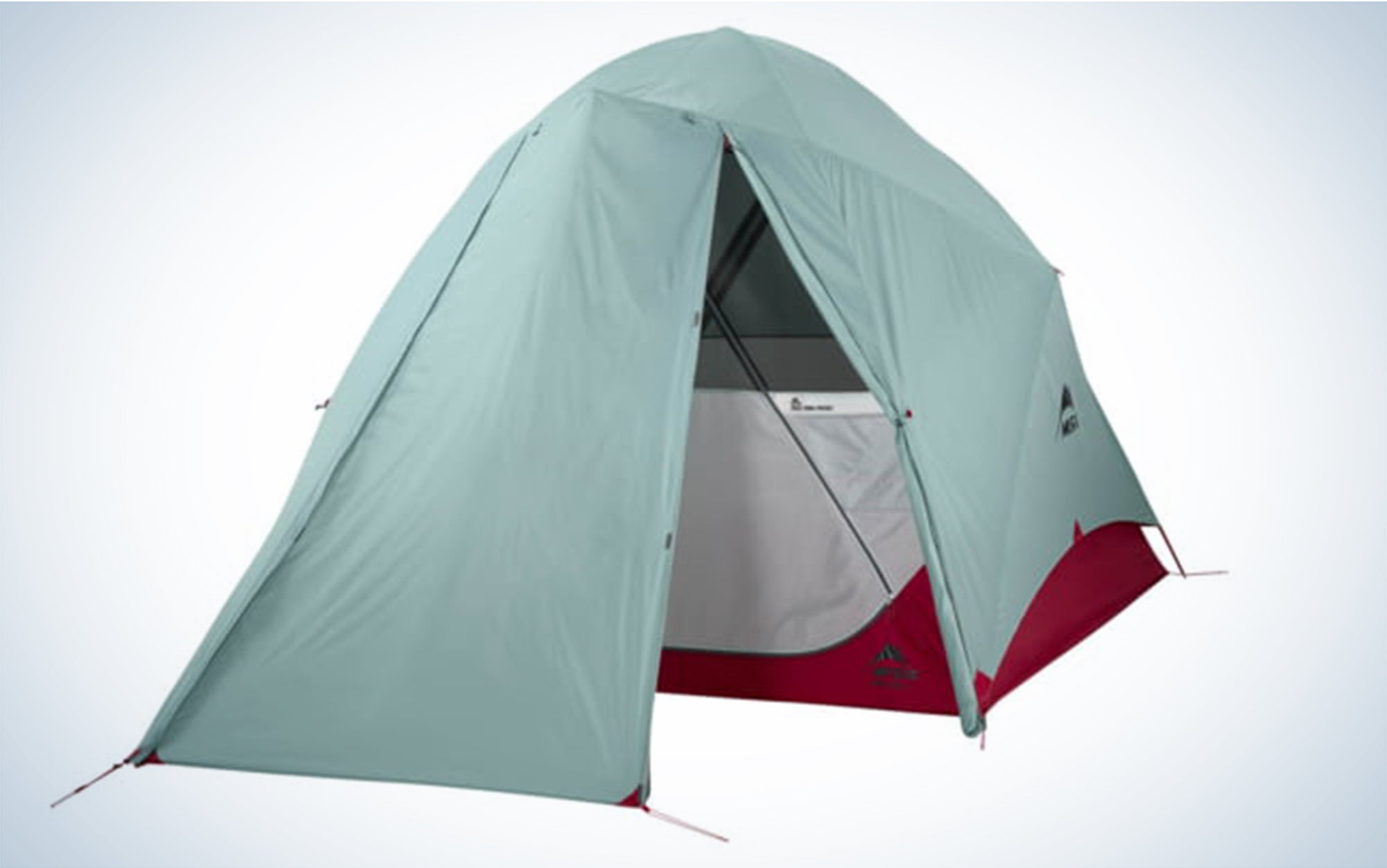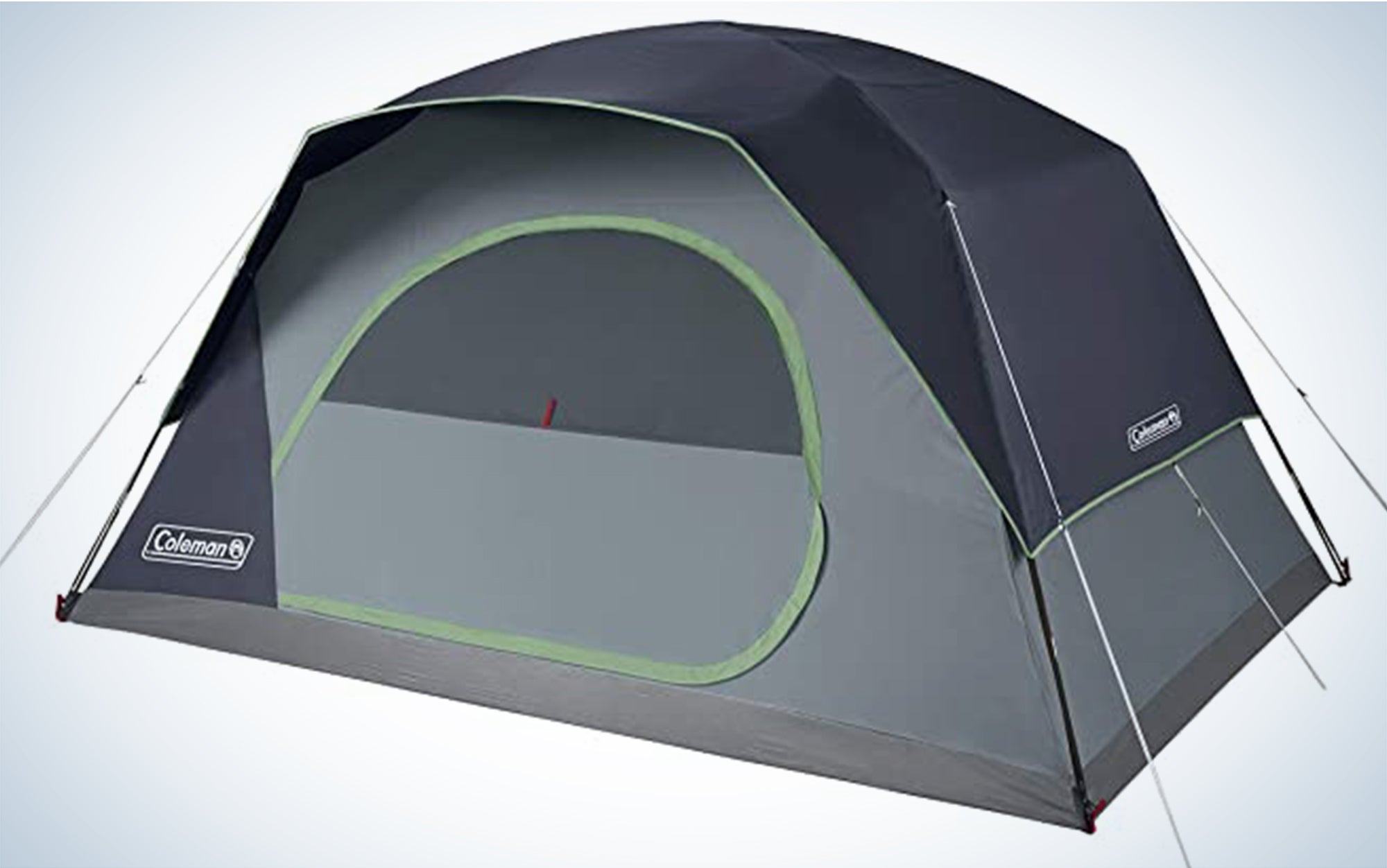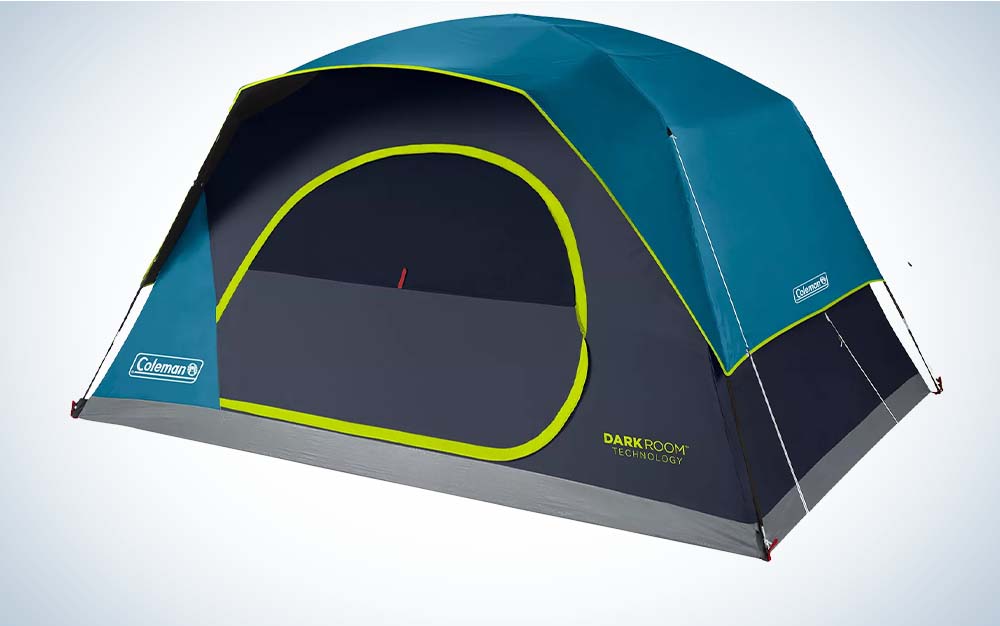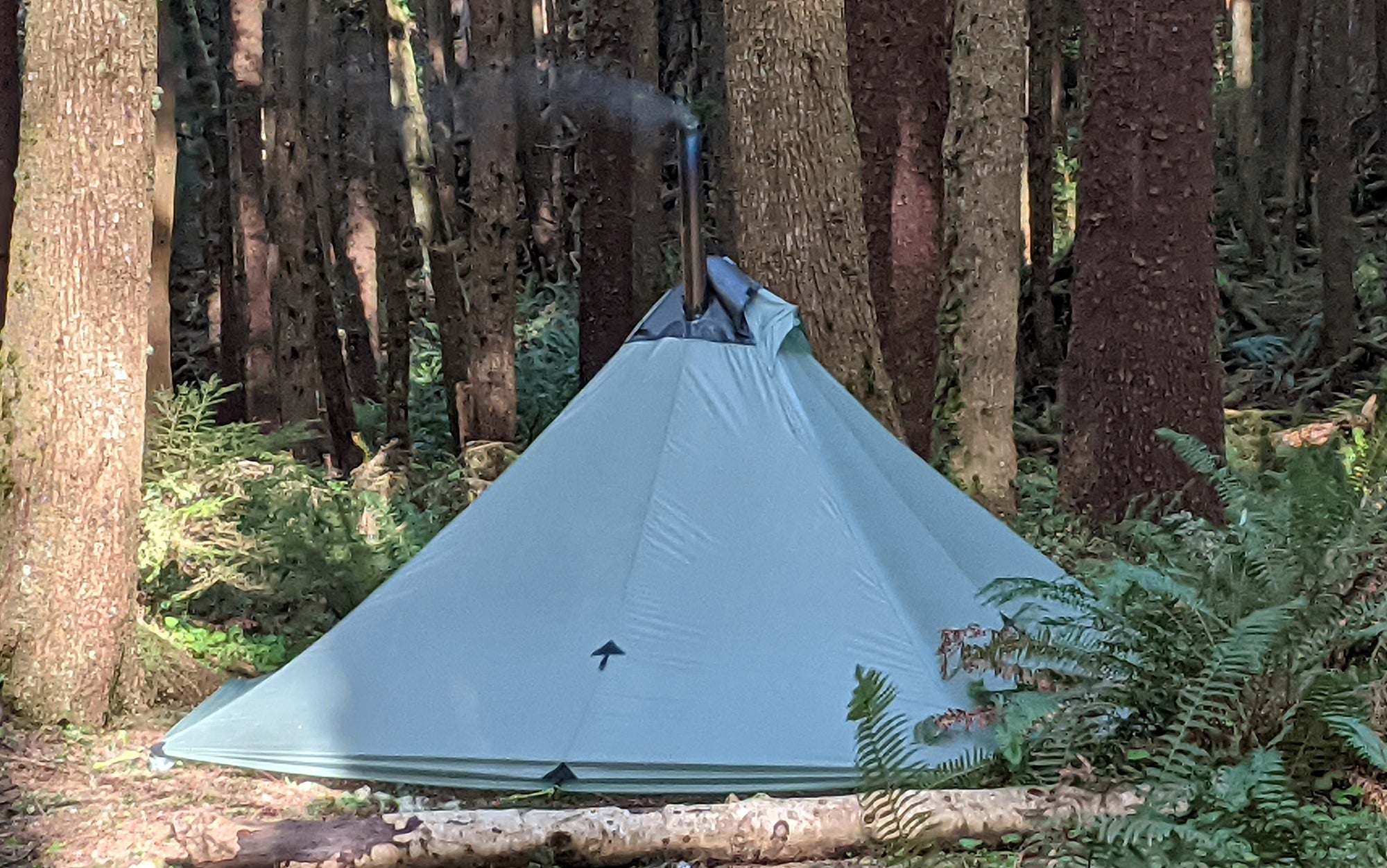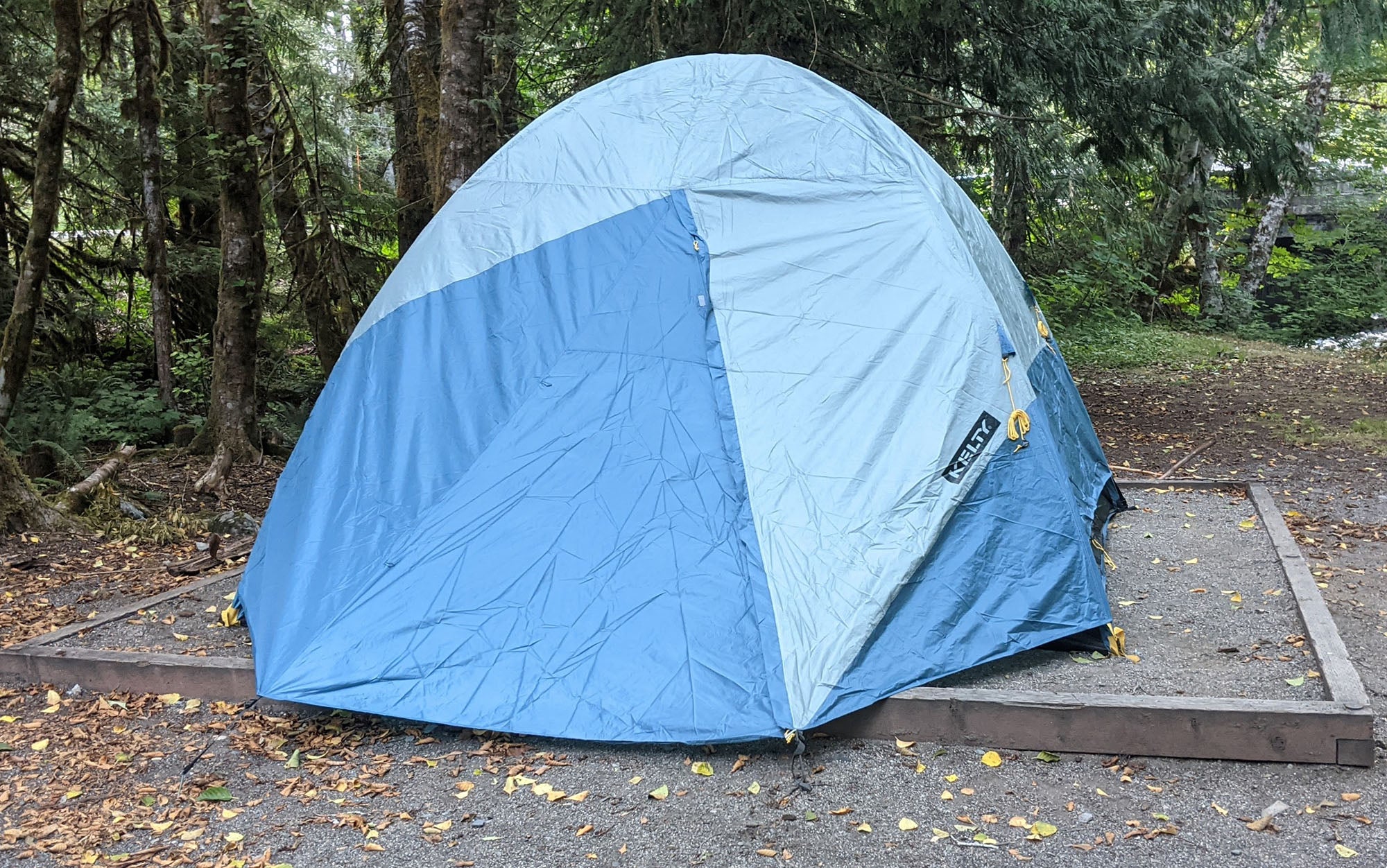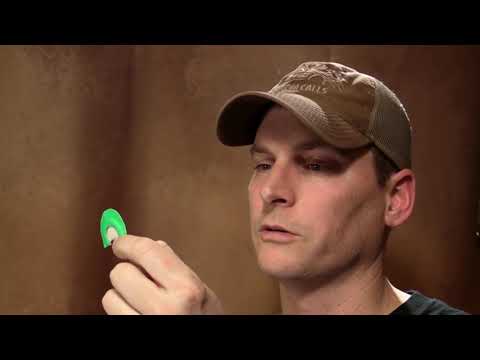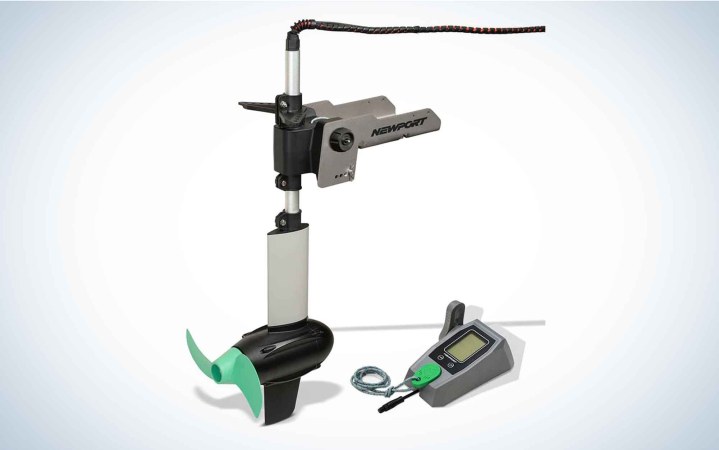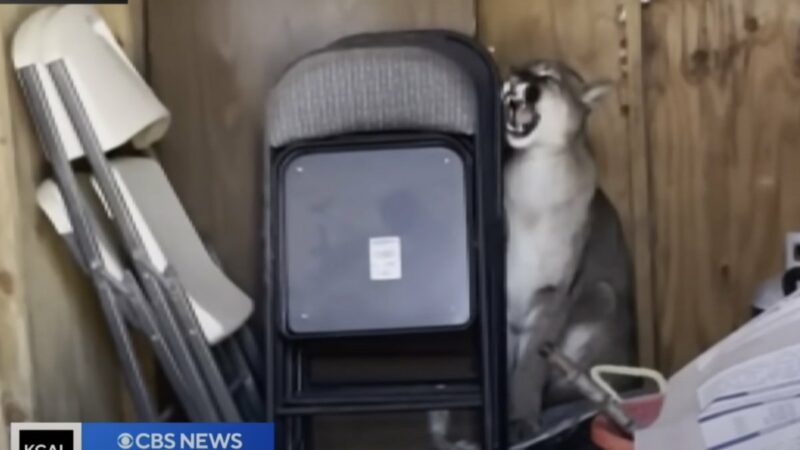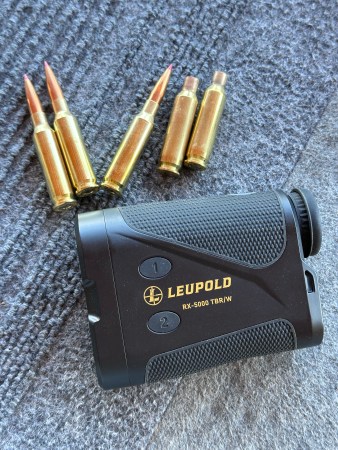The Best Family Tents of 2023
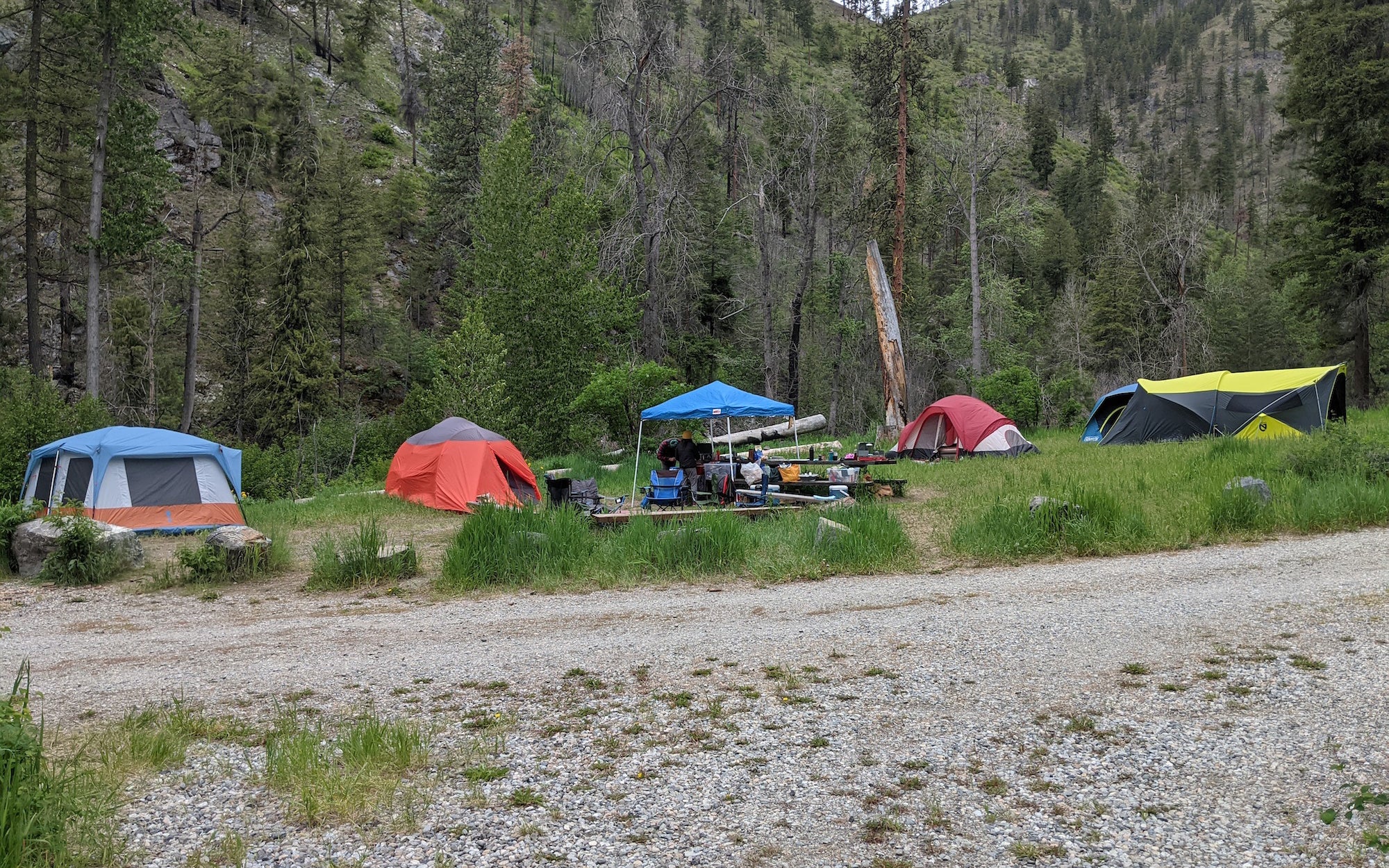
We may earn revenue from the products available on this page and participate in affiliate programs. Learn More ›
| Best for Backpacking | 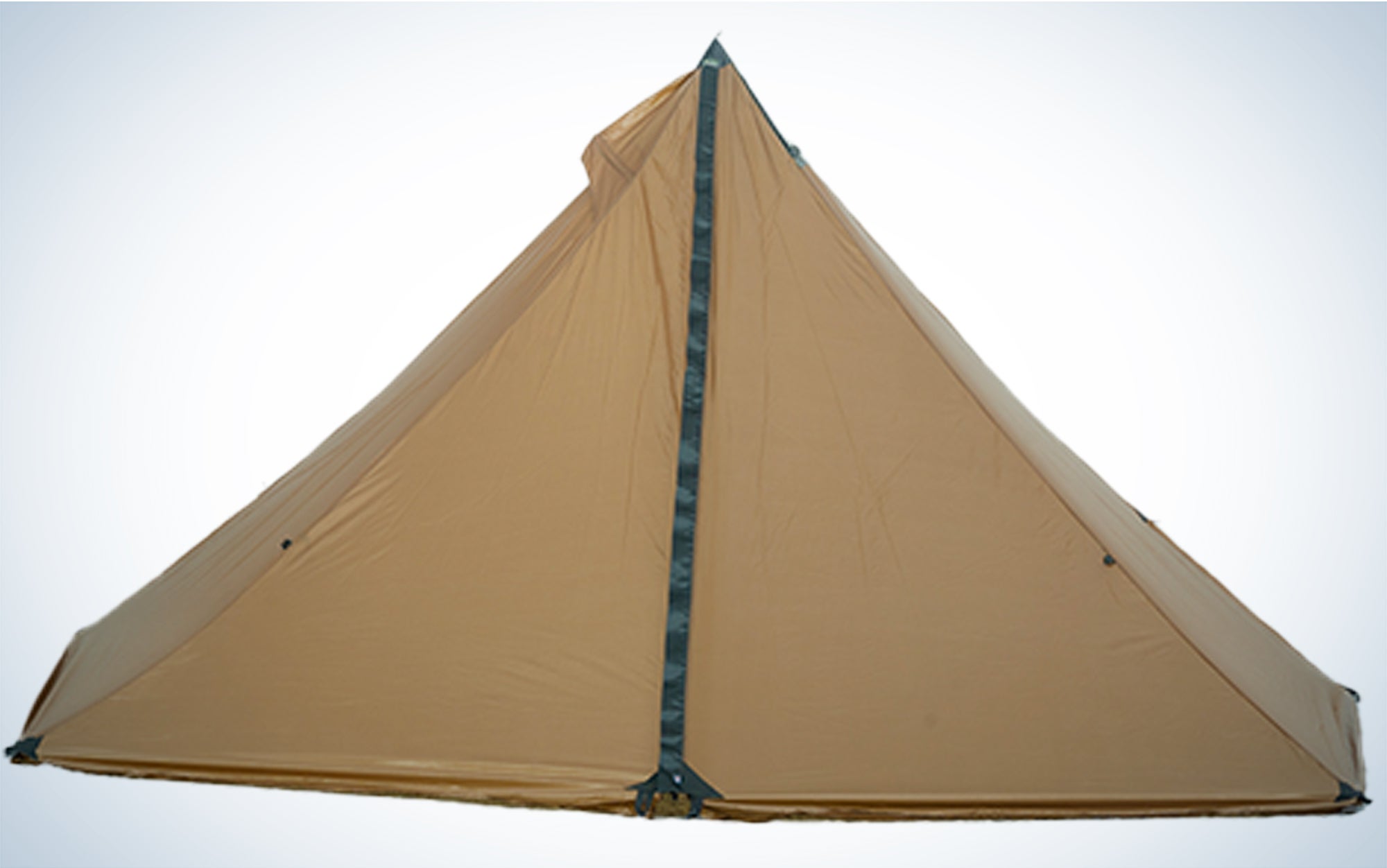 |
Seek Outside Cimarron | SEE IT |
LEARN MORE
|
Summary
Sub three pounds gets you enough space for four people |
| Best for Families of Four | 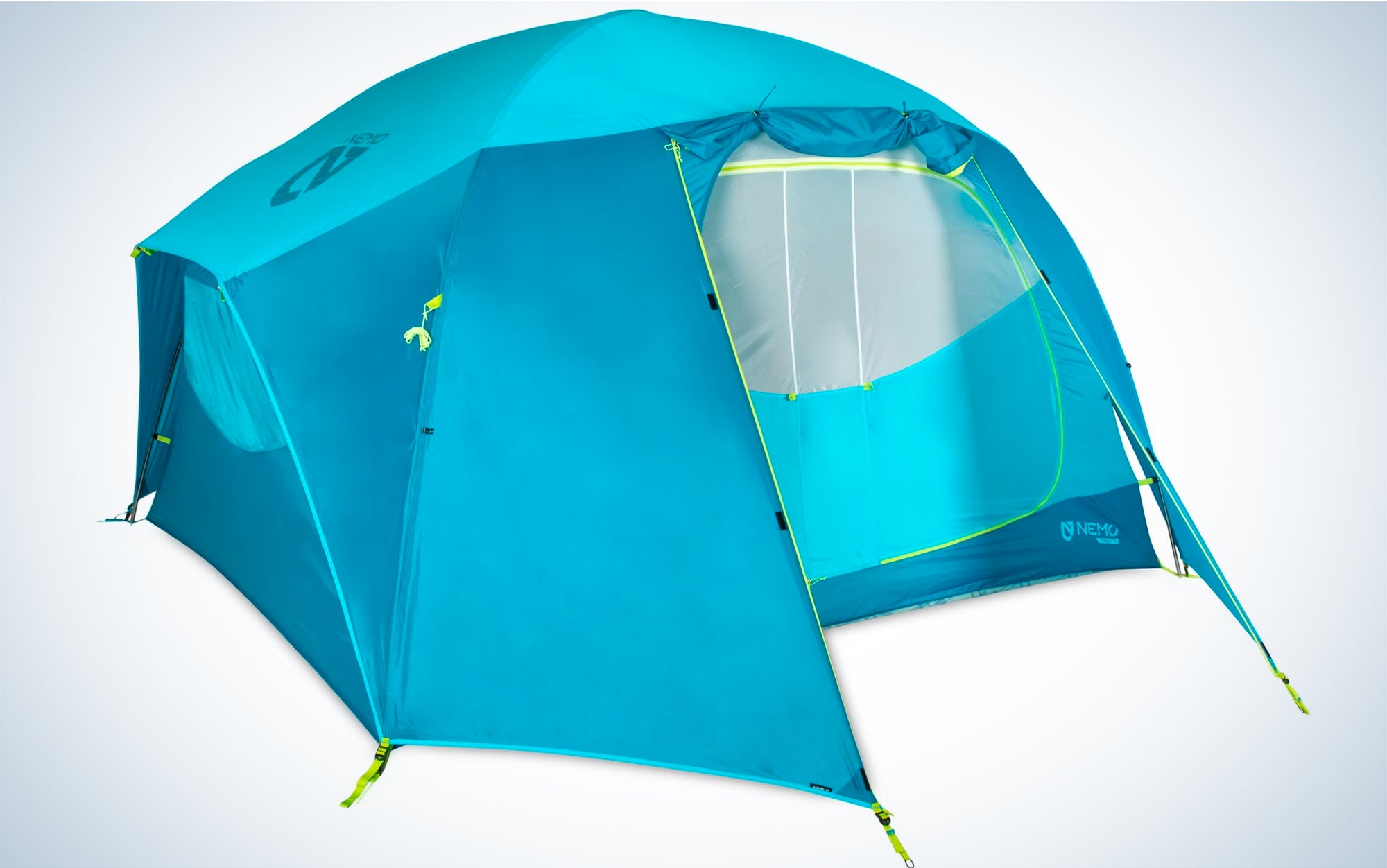 |
NEMO Aurora Highrise 6P | SEE IT |
LEARN MORE
|
Summary
One-person setup with a great interior |
| Best Overall | 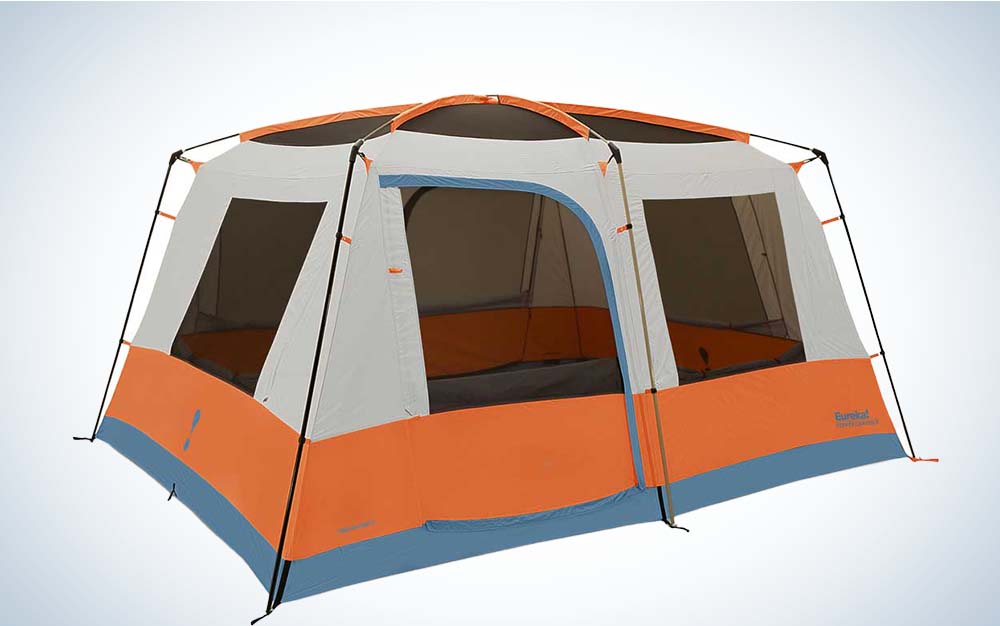 |
Eureka Copper Canyon LX8 | SEE IT |
LEARN MORE
|
Summary
Affordability, spacious interior, and storm readiness |
There is no more important piece of gear on camping trips than the family tent. But with so many tent designs, materials, and features available, it can be tough to know which is the best—especially if you have a larger family that needs space to spread out. I tested top picks from NEMO, Big Agnes, Coleman, MSR, Eureka, Kelty, and more in everything from thunderstorms to heavy winds to help you find the best family tent for your next camping adventure.
- Best Overall: Eureka Copper Canyon LX8
- Best for Six-Person Families: NEMO Wagontop
- Best for Four-Person Families: NEMO Aurora Highrise 6P
- Best for Three People: MSR Habiscape 4P
- Best for Two People: Coleman Skydome 2-Person
- Best Blackout: Coleman 4-Person Dark Room Skydome
- Best for Backpacking: Seek Outside Cimarron
- Best Value: Kelty Discovery Element 6
How We Tested the Best Family Tents
I conducted field tests of tents across a range of size and activities with the help of Outdoor Life staff, friends, and my family. The best 8-person tents were tested over three days in a river valley where heavy winds broke the poles of one tent (and sprung a leak in another). The best 6-person tents were tested in the heavy rain of a late summer thunderstorm. Our pick for backpackers looking for a family tent was part of our test of the best ultralight tents. Other tents included on this list have been taken out with my own family on various camping trips in heat, wind, and rain across our usual stomping grounds of the Pacific Northwest.
Best Family Tents: Reviews & Recommendations
Best Overall: Eureka Copper Canyon LX8
Eureka
Key Features
- Dimensions: 13 feet x 10 feet
- Height: 7 feet
- Weight: 33.5 pounds
- Poles: 10
- Packed Size: 11 inches x 29 inches
- Doors: 2
- Windows: 6
- Also available as a 6-person tent and 4-person tent
Pros
- Great livable space on the interior
- Withstood both rain and wind on the testing trip
- Lots of doors and windows
- Great value
Cons
- Most complicated setup in my test (fortunately the provided instructions were easy to follow)
- Heavy
I was a little skeptical when I first started linking together the poles of the Eureka Copper Canyon LX8. Six windows and two doors, with a rain fly that looked suspiciously like a camping canopy? With winds gusting during and after setup, I kept a close eye on this one
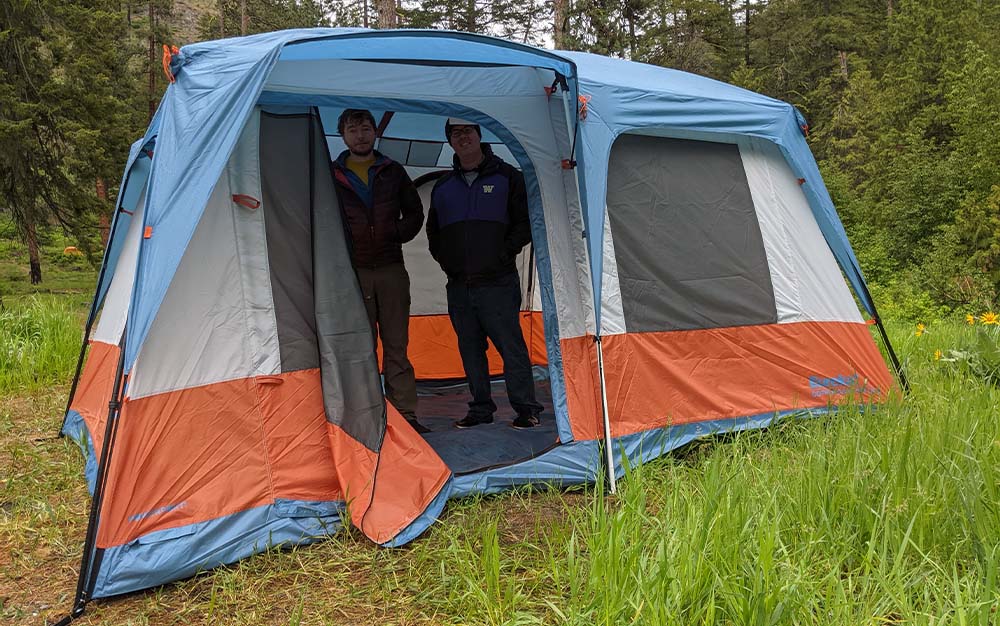
While the strongest winds during testing buffeted the sides of this tent, it bounced back quickly without damaging the fiberglass poles. At one point the rainfly came unattached at a corner, but after a member of the testing group re-secured it with the provided velcro tabs (which I forgot to do during the initial setup), it wasn’t a problem. And the rainfly turned out to be plenty of protection against overnight rain once the windows were zippered up.
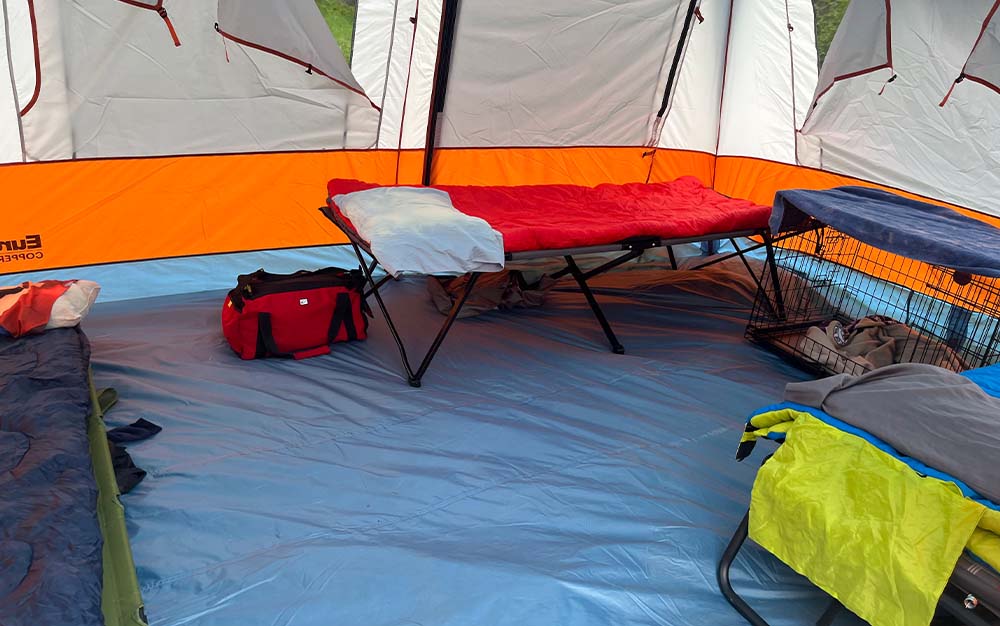
Even better, the ceiling height (seven feet) combined with the near-vertical walls on this one made it easy for the 6-foot 1-inch member of the family to walk around without having to stoop at the edges.
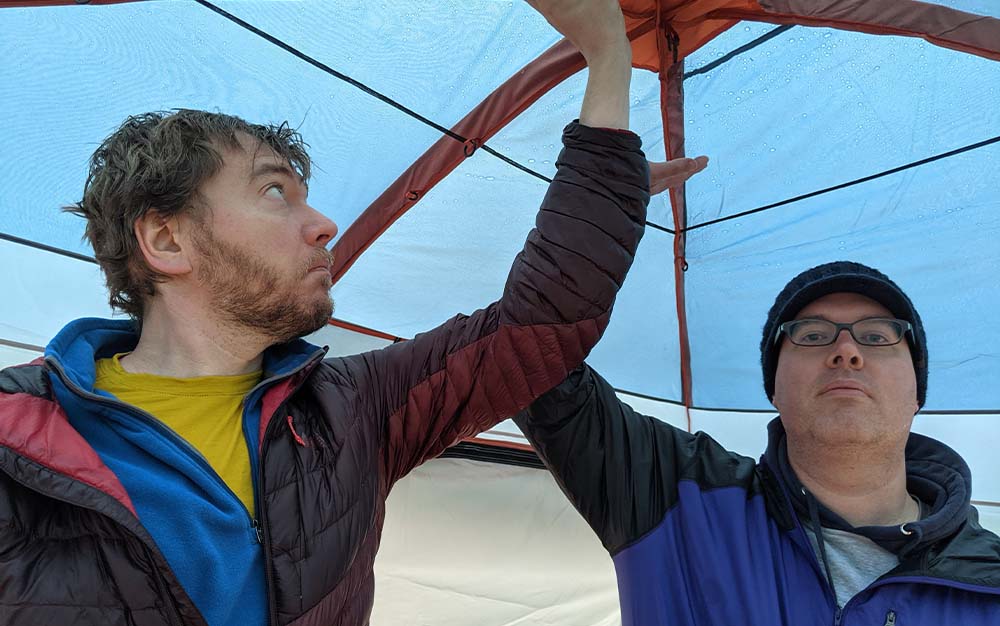
Setup is straightforward, if a little complicated. Three fiberglass poles crisscross the ceiling and then connect to six steel poles at each end to form the walls (the tenth pole creates the awning over the doorway). The directions for this were reasonably easy to follow—it just took a while. The only downside to this tent is that the 8-person tent requires a second person to complete the setup. While I was able to put up the body of the tent by myself, putting up the rainfly requried a second (taller) person.
Best for Six-Person Families: NEMO Wagontop 8-Person Camping Tent
NEMO
Key Features
- Dimensions: 15 feet x 8.3 feet
- Height: 6.5 feet
- Weight: 30 pounds, 3 ounces
- Poles: Three
- Packed Size: 28 inches x 13 inches x 13 inches
- Doors: Two
- Windows: Two
Pros
- Large interior space would easily accommodate three Queen-size camping mattresses
- Single person setup
- Handled winds better than any tent in my test
Cons
- Leaked (small, but still) in the rain
- Expensive
Given the massive size of the NEMO Wagontop 8, 125 square feet and over 6.5-feet tall, I was surprised that I was able to set this one up by myself. The interior of was similarly impressive, wide enough to accommodate 3 Queen-size air mattresses, and my family of three was swimming in it (no complaints here). If you are looking for a true 8-person tent, this one is getting awfully close—my estimate is that you could comfortably fit seven adults on single pads in this one. Its combination of interior space and head height is what makes it a no-brainer for families of six.
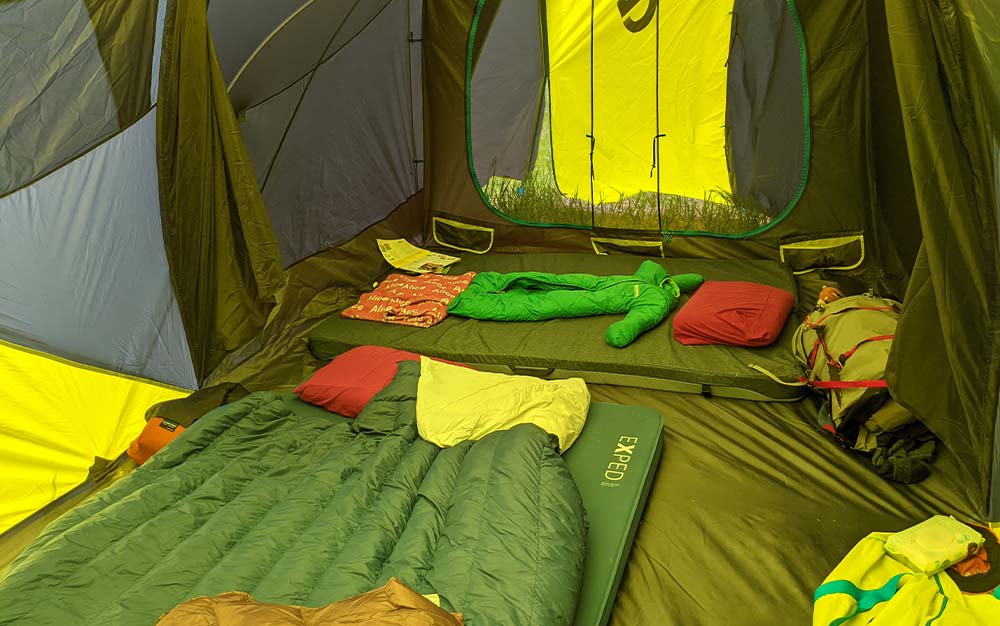
What makes this tent’s setup unique for its size is that the rainfly is attached to the center of the tent, so it doesn’t need to be thrown over the top after you have the body up. But that isn’t to say that the setup of the Wagontop 8 was a breeze. The tent design here is unusual, and even after checking the directions it took me two tries to get the poles set up in the right direction.
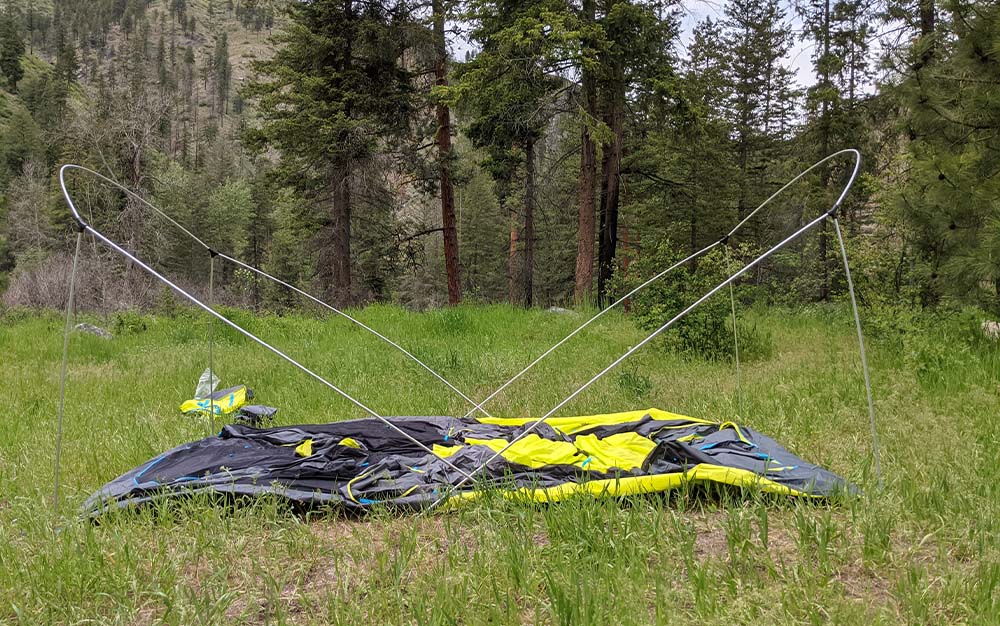
But once I had the poles up correctly, it was a cinch to snap up the body of the tent, thread the middle pole through the center line, and secure the rainfly over the top of the tent.
This was the first tent I set up in my test of the best 8-person tents, when the winds were gusting the most, and I was impressed with how the Wagtontop 8 handled the less-than-ideal weather. Even when the tent walls buffeted, the integrity of the poles held fast, not bending in the slightest. Given the weather conditions, I chose to secure several of the guylines of this tent in addition to tightening the rainfly flaps and checking that the stakes were providing sufficient tension.
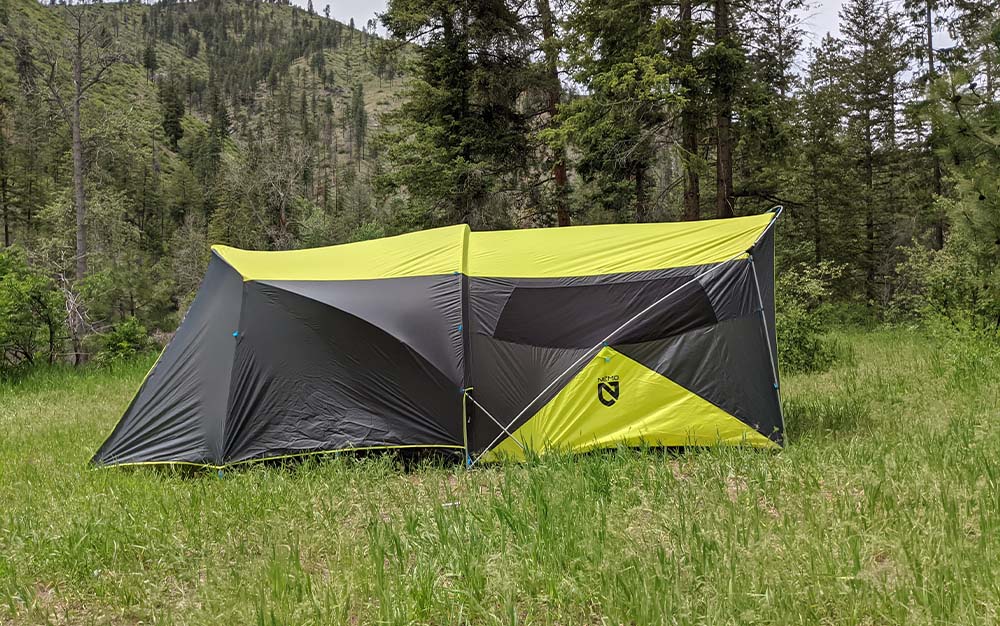
Unfortunately, the position of the guylines were low enough that the solid ceiling portion of the tent (without the rainfly) continued to buffet in the wind. Fortunately, the winds died down before it was time to put our toddler to bed.
While the Wagontop 8 handled the wind great on my test of the best 8-person tents, it did develop a small leak when it rained overnight, right in the center of the tent. During disassembly, the reason for this became clear: a sizeable amount of water that had pooled at the top of the tent poured off after I removed the center pole. I suspect that this leak might not have occurred if the tent had been pulled taut, but after three days of wind this tent had developed some slack, even with a number of the guylines up. Given the price of this tent, I would have expected it to handle the rain better, especially given that these were intermittent PNW showers, not a true downpour. If you expect overnight rain, be sure to check that the tent is taut before you tuck in for the night.
Best for Four-Person Families: NEMO Aurora Highrise 6P
Laura Lancaster
Key Features
- Dimensions: 100 x 120 inches (83.3 square feet)
- Height: 77 inches
- Weight: 18 pounds, 10 ounces
- Poles: Four
- Packed Size: 26 x 9.5 x 9.5 inches
- Doors: Two
- Windows: Two
Pros
- Easy one-person set up
- Plenty of vestibule space
- Great headroom across the interior of the tent
- Spacious floor design allows for different configurations
Cons
- Window closure mechanism is not as secure as it could be
- The blue interior color is very intense
I barely remember setting up the NEMO Aurora Highrise 6P Tent, which is about the highest praise I can offer. Insert the two longest poles through the crisscrossing sleeves, anchor them into the grommets at opposite ends, and secure a handful of tabs to pull the body taut.
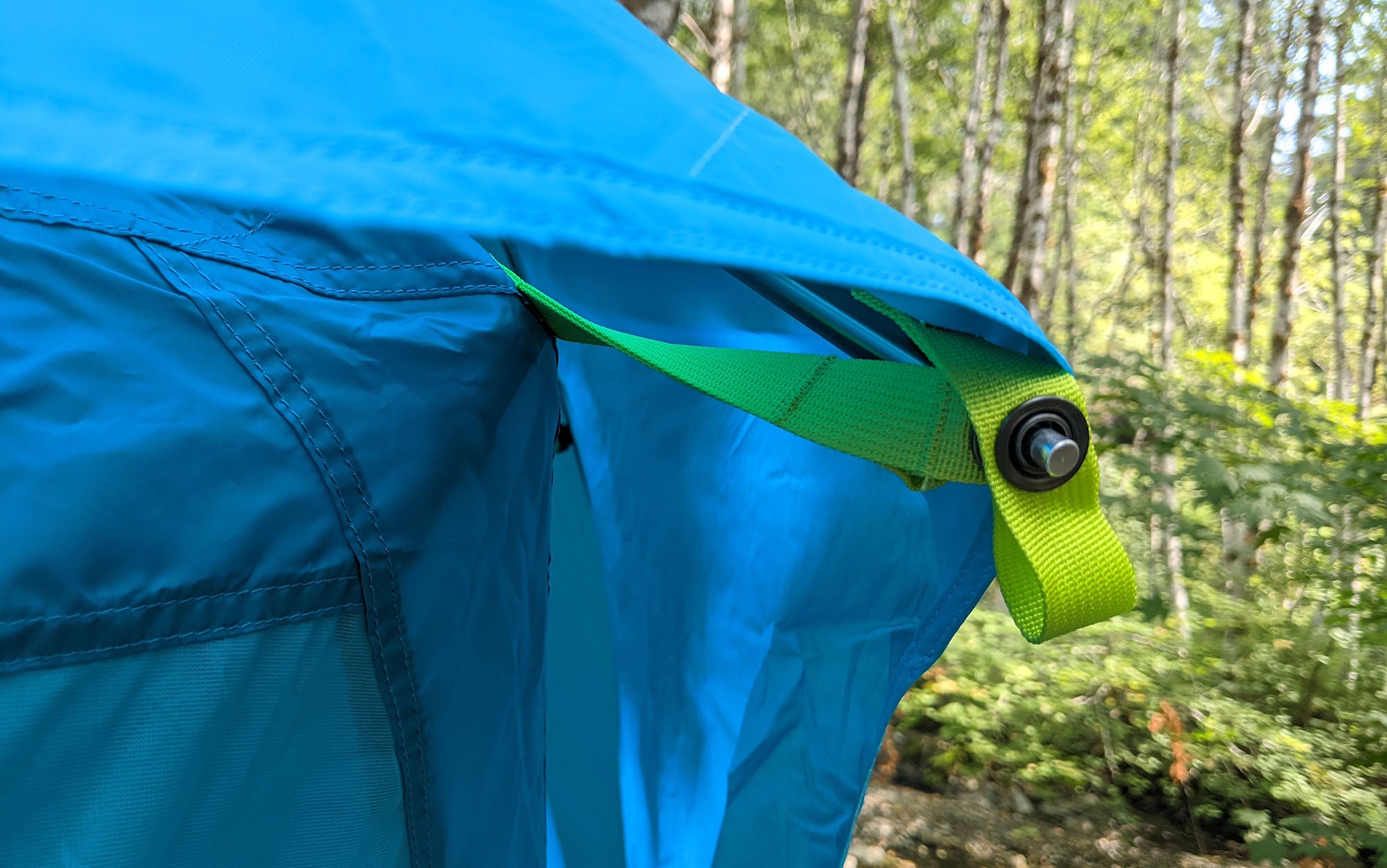
Something nice about the NEMO Aurora Highrise 6P Tent was that the two lengthwise poles attached to the rainfly, and were pretty taut (although not unnecessarily difficult to get into place), which helped to keep the rainfly off of the body of the tent. That ended up being extra important as the ground at my testing site turned out to be fairly difficult to stake into.
On the tent pads, the ground was firm but pliable—ideal for staking in—but everywhere else it was very compacted, and virtually impossible to get more than an inch in. This is a common scenario for car camping these days, so I was curious to see how the tents would handle the less than ideal staking situation. But I was less worried about my poor staking job with the NEMO Aurora Highrise 6P Tent because of the taut structure provided by the poles and fly alone.
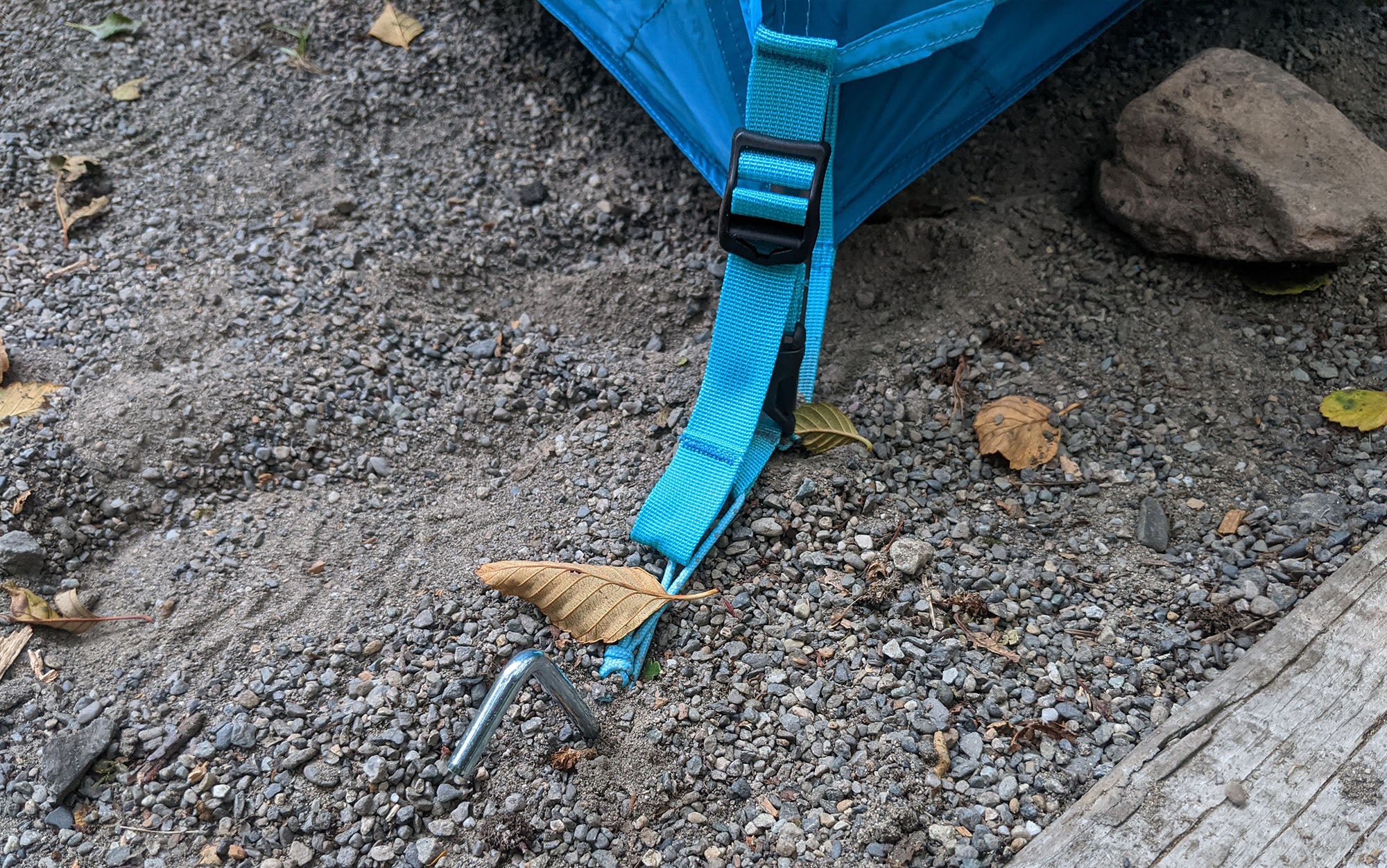
The bright glowing blue of the interior is perhaps the most memorable (and divisive) part of this tent. It’s very blue. It sort of offers the impression of a bright sunny day, even as the clouds rolled in—PNWers may be reminded of an infamous Pemco commercial. Unfortunately, that means it also washes out all other colors. Personally, I might have chosen a different color if NEMO offered one (they don’t, currently).
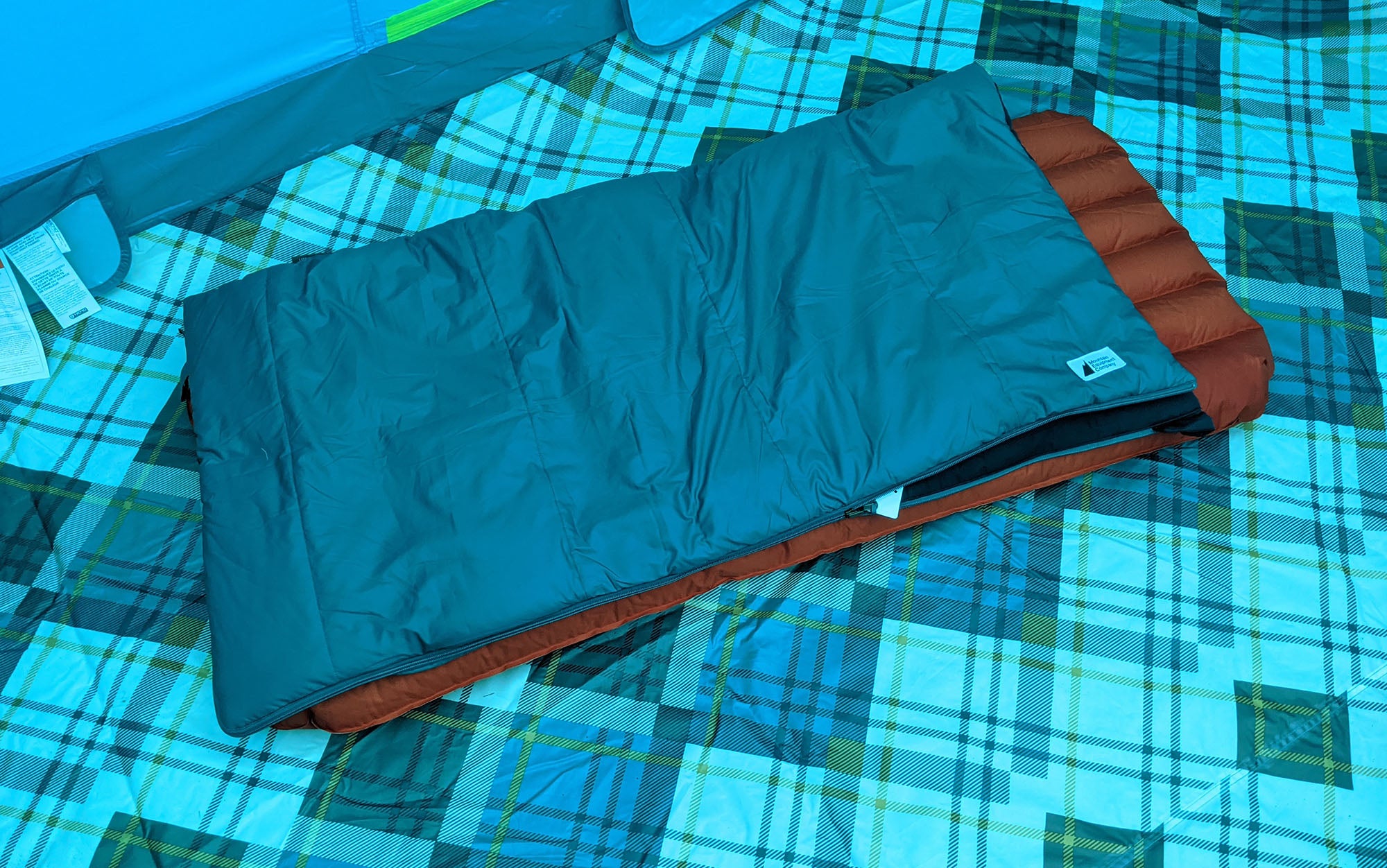
There was an unusually serious thunderstorm the night I tented this test. Rain was dumping. The sky was booming. The Aurora Highrise held taut against the rain. I spent some time considering the relative distance between our location and the actual lightning strikes (no camping tent is going to protect you from a direct hit), but once I was comfortable it wasn’t headed our way, it was easy to fall back asleep again. I just felt safe in this tent.
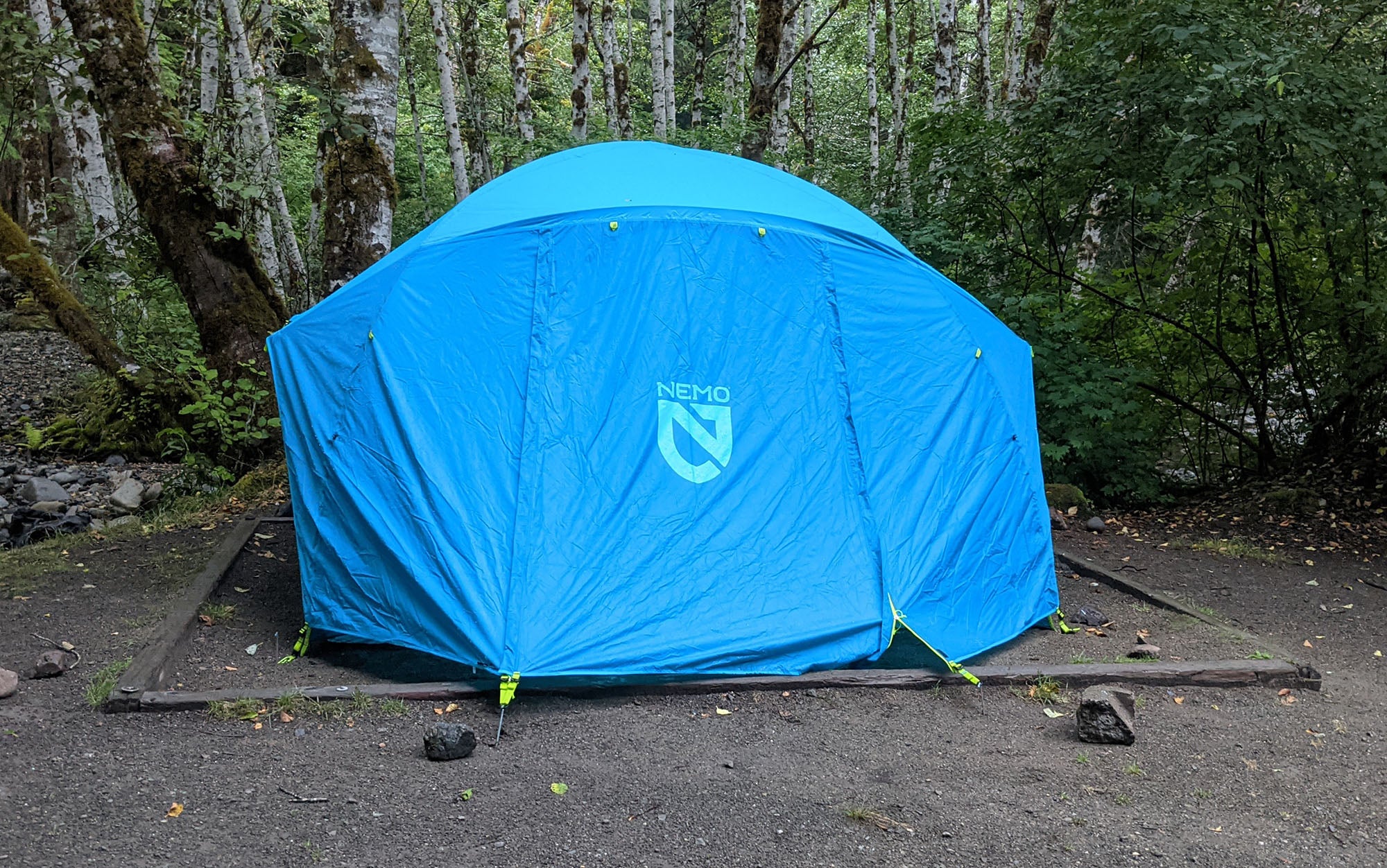
Beyond the blue coloring, my only other concern with this tent was the windows at the side. They close up from the inside with a simple toggle mechanism. While this wasn’t an issue with a straight up and down rainfall (the rainfly covers it by a few inches), in a storm involving both rain and wind, this could prove to be a failpoint.
Best for Three People: MSR Habiscape
MSR
Key Features
- Dimensions: 95 x 95 inches (62.5 square feet)
- Height: 73 inches
- Weight: 12 pounds, 11 ounces
- Poles: Six
- Packed Size: 24 x 9 inches
- Doors: Two
- Windows: None
Pros
- High ceiling height extends around the tent
- Great stuff sack
- Designed to handle inclement weather
Cons
- Smaller vestibule than other 4-person tents
The MSR Habiscape is one of those tents that doesn’t look like much when you first set it up, but the longer you spend with it, the more it starts to grow on you. It starts with the headspace—plenty enough for this five-foot-five gear writer to stand up in, not just at the center, but also along the sides and at the doors. Then there are the pockets—10 in total—including two that can be accessed from outside the tent (no more taking off and putting on your rain jacket and shoes just to store the car keys).
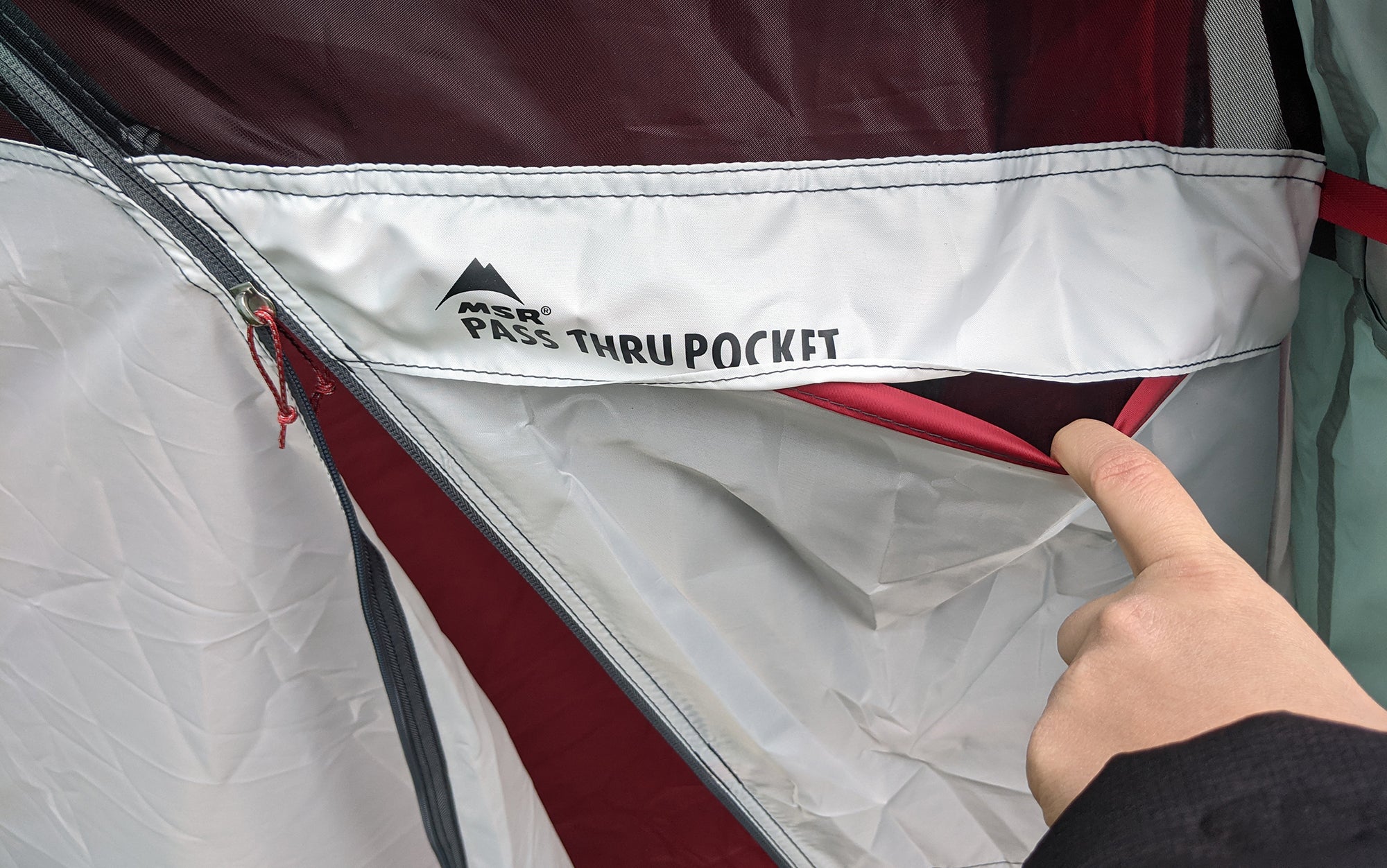
Finally, the stuff sack was great. That might seem like an unimportant detail when you are first setting up your tent, but when it’s time to pack away at the end of the weekend—the rainfly soaked from an overnight shower, dirt stuck to the bottom of the body—the excellence of the stuff sack becomes clear.
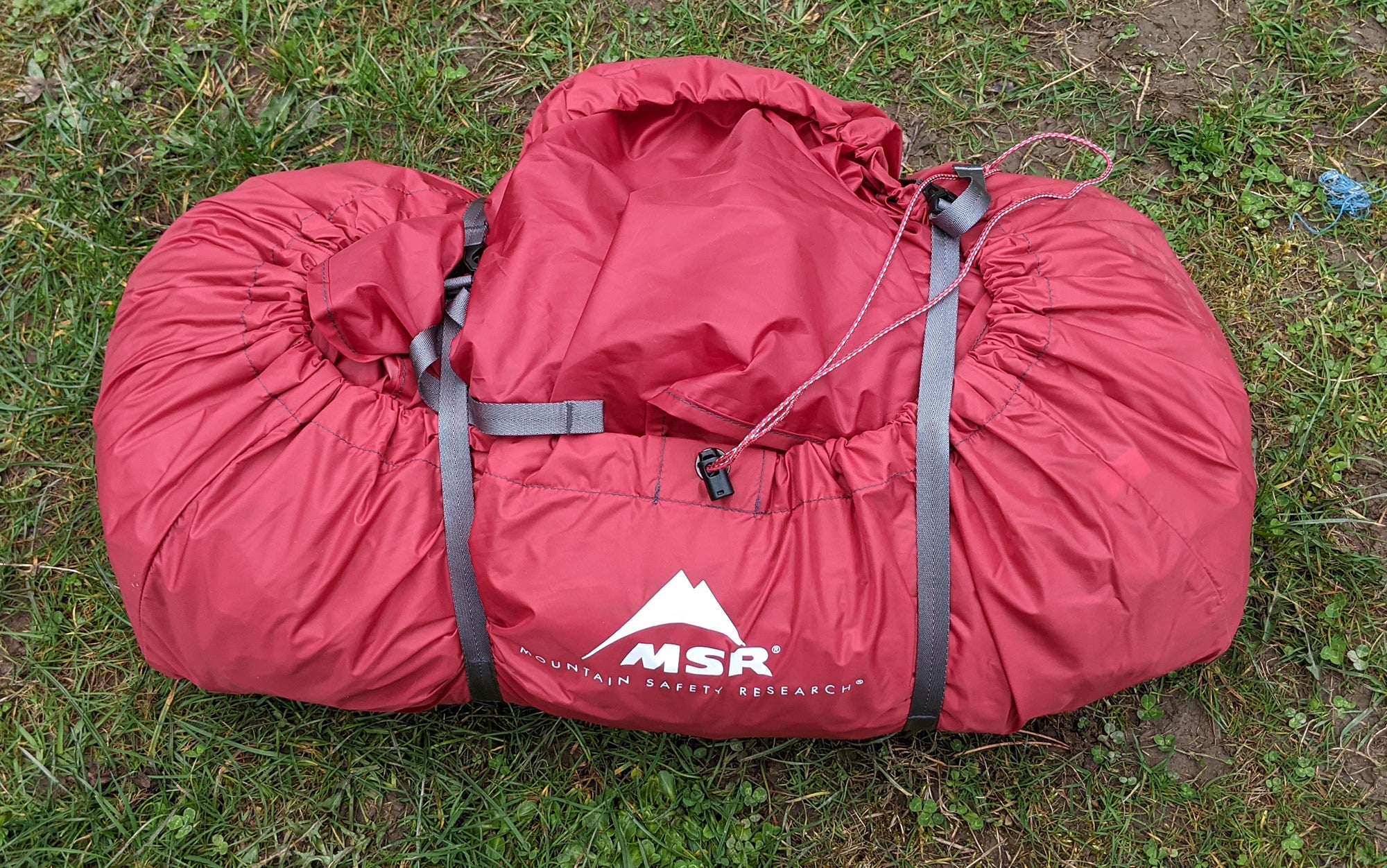
While most tent stuff sacks open at the end, the MSR Habitude stuff sack opens along the side. After a drizzly morning of testing, instead of carefully rolling up the tent into a cylindrical burrito, I simply stuffed the rainfly and body in as best I could, shoved the stake and pole bags on top, cinched the cord and tightened the compression straps. It wasn’t pretty, but it was now ready for transport with a minimum of hassle.
Best for Two People: Coleman Skydome 2-Person
Coleman
Key Features
- Dimensions: 84 x 60 inches
- Height: 48 inches
- Weight: 9 pounds, 10 ounces
- Poles: Three
- Doors: One
- Windows: None
Pros
- Tallest ceiling of any 2-person tent I’ve tested
- Roomy fit for two people
- Low price
- Heavy-duty bathtub floor excels at keeping puddles at bay
Cons
- Small vestibule door
- Fly setup is less straightforward than the tent
The Coleman Skydome 2-Person Camping Tent was my pick as one of the best two-person tents for a number of reasons: It’s relatively simple to set up, it’s got a spacious interior, and it’s affordable.
You’ll inevitably spend a little more time in your tent car camping than backpacking. Lazy early mornings, an outfit change after your afternoon hike, a pre-dinner nap—so you want a tent that you, and your camping partner, can stretch out comfortably in. Besides having the most generous square footage of any tent in that test, what set the Coleman Skydome Tent apart from its competition was its height: an impressive four feet. While many 2-person tents only have space for one person, the 60 inches of width means that not only can you fit yourself and your adventure partner (snuggling optional; the tent is wide enough to accommodate a queen-size sleeping pad), but also a four-legged friend.
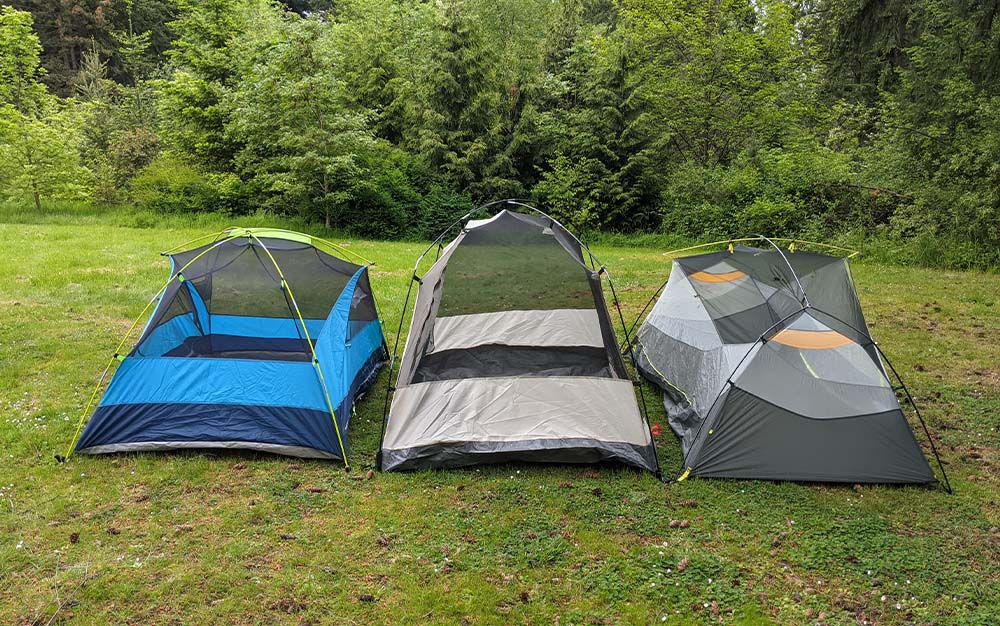
The drawback of this tent is that it is less intuitive to set up than others in my test—I had to go back to the directions multiple times to figure it out. The two poles, which are connected to the tent body (a boon to anyone who has ever forgotten their poles at home) snapped into place with the end sliding easily into a pouch on the opposite corner and the tabs clicking into place. But when it came time to put on the rainfly, it took some searching to figure out where the pole slid into the underside of the rainfly. But once it was set up, the trouble was worth it, as this is the best awning I’ve ever seen on a two-person tent—better than a lot of four-person tents.
Best Blackout: Coleman 4-Person Dark Room Skydome
Coleman
Key Features
- Dimensions: 12 x 9 feet
- Height: 76 inches
- Weight: 20.5 pounds
- Poles: 3
- Packed Size: 27 x 10 x 9 inches
- Doors: 1
- Windows: 0
Pros
- Dark interior is perfect for midday naps or camping during the summer solstice
- Reasonably easy setup
- Affordably priced
Cons
- Smaller than other tents in my test (would only fit two Queen-size camping mattresses)
If you’ve ever planned to sleep in while camping, then woken up as soon as the sun hits your tent at five in the morning, then the appeal of the Coleman Dark Room Skydome is pretty clear. In the middle of the day, with the sun brightly shining down on you, you can go inside this tent and it’s pretty close to pitch black. Just a small amount of light sneaks in at the corners and around the edge of the door. It’s also much cooler than comparably enclosed tents.
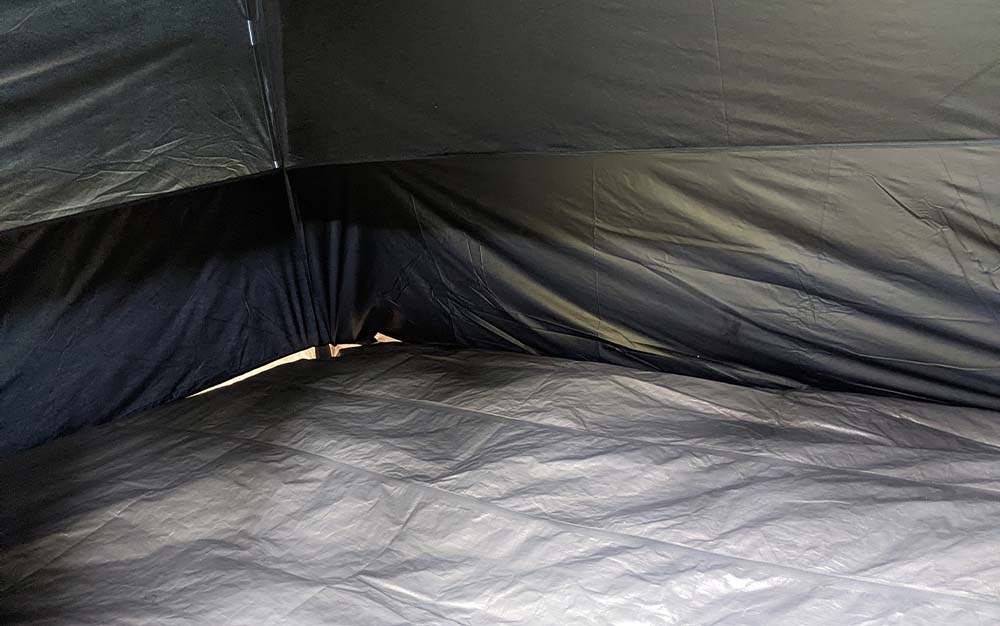
This tent (I tested the 8-person version, but it’s available as a 4-person or a 10-person) was also fairly easy to set up. The two main poles, which are attached to the far corners of the tent, simply crisscross over each side—a super simple design that will be familiar to anyone who has ever used a 2-person tent. Unfortunately, this design also comes with some limitations. At 108 square feet, this was the smallest so-called 8-person tent in my test. I would not recommend trying to squeeze more than four people in this tent, maybe five if you are exceptionally good friends. It also buffeted in the wind fairly significantly, although the fiberglass poles survived the encounter.
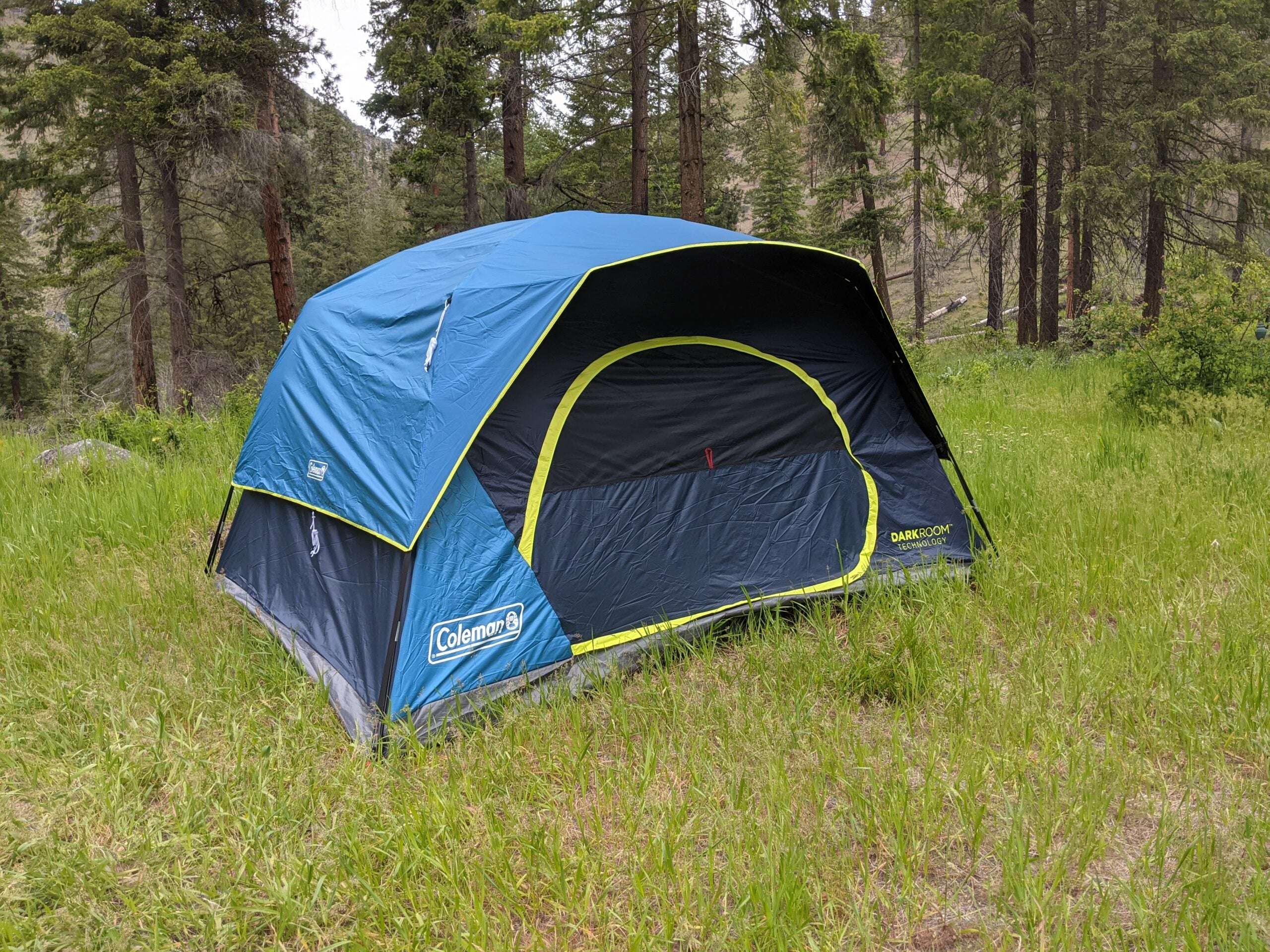
The final pole—a separate fiberglass section that holds the rainfly out over the door was surprisingly difficult to insert.
Best for Backpacking: Seek Outside Cimarron
Laura Lancaster
Key Features
- Dimensions: 114 x 102 inches
- Height: 72 inches
- Weight: 2 pounds, 7 ounces (not including the optional stove)
- Poles: One (not freestanding)
- Doors: 1
- Windows: 0
Pros
- Straight-forward set up
- Very lightweight for its footprint
- Came with some the best tent stakes of any ultralight tent I looked at
- Option to pair with a lightweight titanium stove
Cons
- Huge footprint can make it hard to find a suitable pitch site
- No floor (option to purchase a floor if you do not plan to use the stove)
First off, the Seek Outside Cimarron is an exceptionally easy tent to set up. The first step is to stake out the four corners of the tent, a task made easier by the long (almost 10 inches) twisted aluminum stakes—I was comfortable pounding these in with a rock and they held significantly better than any other stakes provided for this test of the best ultralight tents. Then simply assemble the pole sections together at the lowest length setting, position it in the center of the tent, and adjust it up until it’s at its highest setting. (If you choose to pair this tent with the stove, it’s a bit more complicated, but still straight-forward enough to assemble.)
Without the stove, this tent is surprisingly spacious on the interior, and would easily fit four adults plus gear (assuming they were careful). If you’re an experienced adventurer looking to take a couple of littles to the backcountry, this is a great option that will leave plenty of space in your pack for all the other essentials.
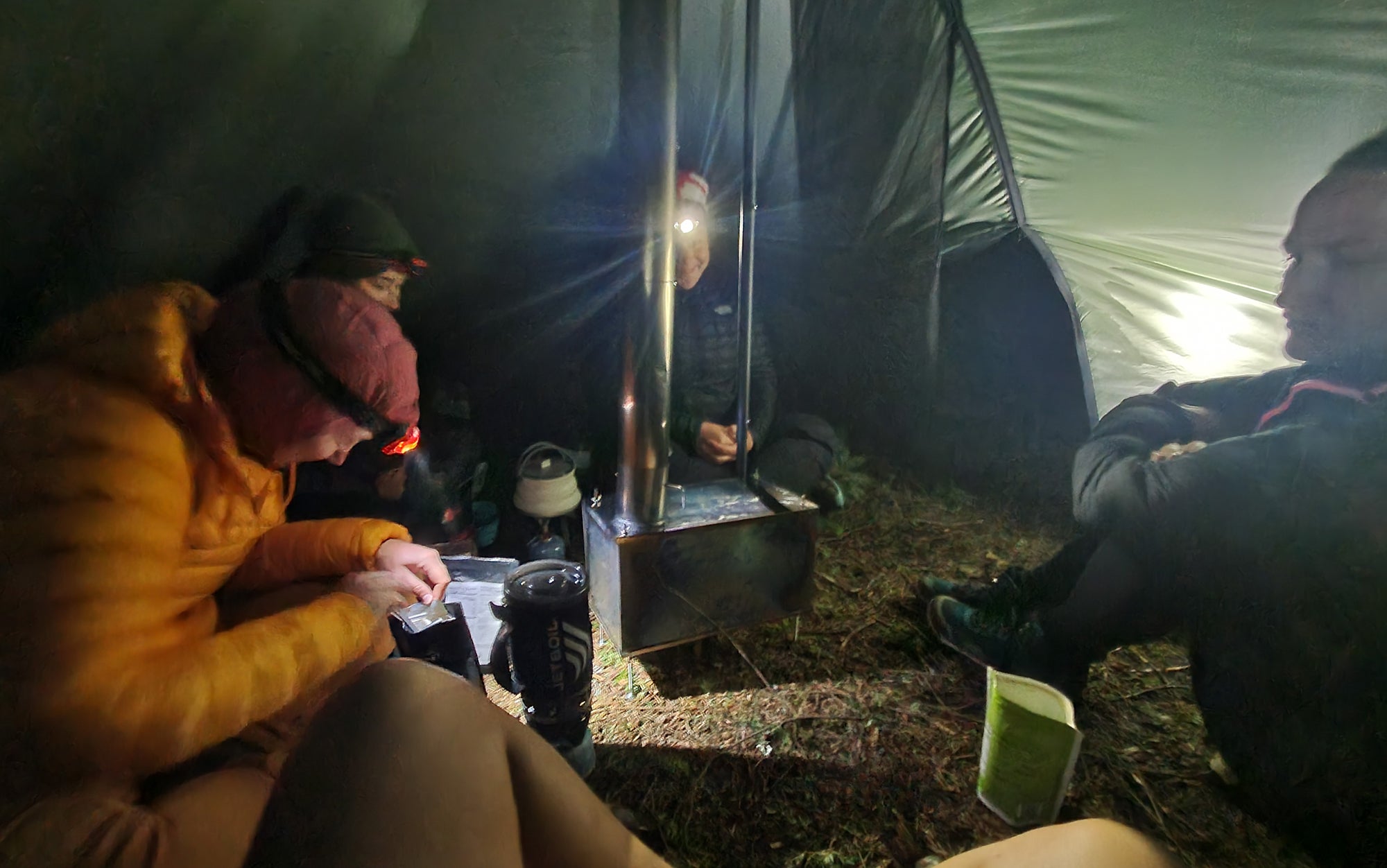
The only pitfall for this tent is that it can be a challenge to find a place for it. With the huge footprint and need to stake the tent down, you might spend more time searching for a spot to set up than actually setting up.
Best Value: Kelty Discovery Element 6
Laura Lancaster
Key Features
- Dimensions: 107 x 120 inches (89 square feet)
- Height: 77 inches
- Weight: 15 pounds, 13 ounces
- Poles: 2
- Doors: 1
- Windows: 0
Pros
- Affordable
- Easy to set up
- Waterproof
Cons
- More claustrophobic interior space than others in my test
- Somewhat less headroom
- Rainfly is not taut unless staked out
Spending $500 on a tent is hard. If you’re outfitting your whole family for the first time, it’s cost prohibitive. That’s why I was so pleased with how well the Kelty Discovery Element 6 handled my testing protocol. With just two crisscrossing poles, it was a cinch to put up. Given that the poles connect into sleeves at opposing corners (rather than fiddly grommets), it was arguably one of the easiest family tents to set up that I’ve tested. If you’re a first-time camper worried about the hassle of tent setup, this one is a great choice.
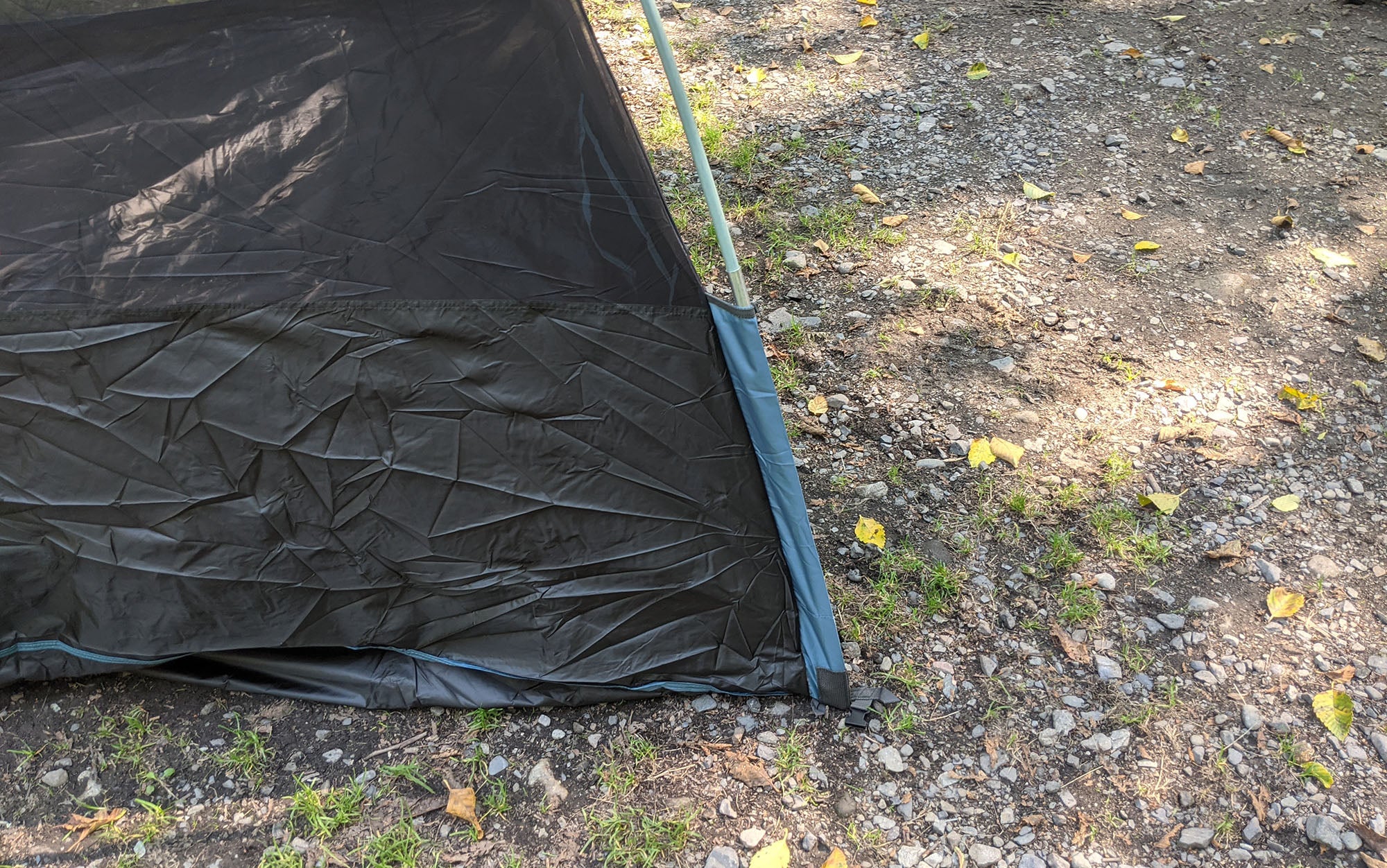
The heavier duty material being used for the Kelty Discovery Element 6 meant that the interior was unusually dark. If you’re camping with young children who still need daytime naps, that can be a boon, but it does mean that you’ll need to have a headlamp or camping flashlight on hand to see anything as soon as dusk settles in. At the end of the aforementioned overnight thunderstorm, this tent was completely dry on the interior.
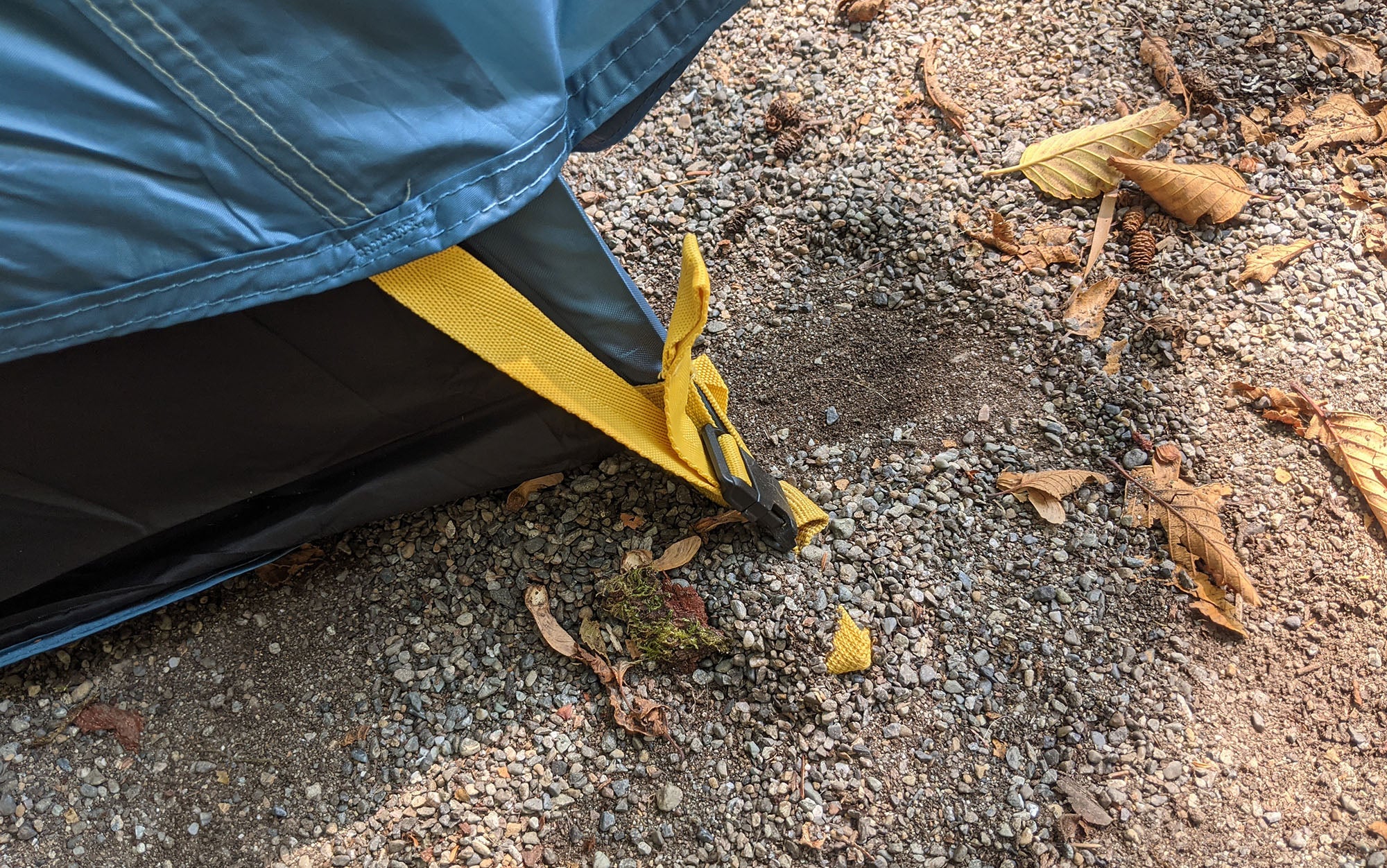
While this is marketed as a 6-person tent, it would be a tight fit for four adults. If you have two small children, your family will likely fit fine, but if you’re kids are approaching full size then consider opting for a larger tents.
How to Choose the Best Camping Tent
Square Footage
As anyone who has bought a tent knows, the stated number of people a tent can fit and the actual number of people you would want to fit in a tent can vary significantly. And gear like sleeping pads and sleeping bags will quickly take up room. Check the dimensions of any tent you are considering to determine whether it will fit the family or group you will be camping with.
Ease of Set Up
While I was able to set up all but one of the six-person tents I looked at by myself, I was only able to set up one of the 8-person tents by myself. If you are camping with young children that need constant supervision, prioritize tents with single-person setup. One rule of thumb that can help you determine how long it will take to set up a tent is to look at the number of poles. Typically, more poles will indicate a longer, more complicated set-up time, while a tent with fewer poles should come together relatively quickly.
Ceiling Height
One of the great joys of a family tent is finally being able to stand up inside. However, easier tents to setup typically have shorter ceiling heights while tents that have upwards of six feet on the interior can be difficult for shorter people to set up independently. Aim for a tent that has just enough head height for the tallest member of your family.
Packed Size
A large footprint unfortunately also means more space taken up in transit. If you have a smaller car, consider choosing a family tent with a smaller packed size.
FAQs
Q: What makes a tent high quality?
The best tent brands are those that have decades of experience in the outdoors, be it camping or backpacking, and are attuned to how the engineering details of a tent make it more or less adaptable to different climates or weather conditions. Most, although not all, also use higher quality material that will typically last longer than lower grade nylon or polyester. Finally, a high-quality tent will have a long warranty period—if a manufacturer isn’t willing to guarantee their tent for more than a season, it probably isn’t any good.
Q: How do I make tent camping comfortable?
The biggest factor in camping comfort is warmth. If you’re cold, you’re going to be uncomfortable. Purchasing a high quality sleeping pad will not only cushion you against the ground, but it will also insulate you from the cold of the ground. When choosing a sleeping bag, look for something rated at least twenty degrees lower than what you expect your coldest overnight temp to be. Bring blankets. Lots of blankets.
Q: Should I worry about tent shape?
There are pros and cons to every tent design. A traditional, straight-walled cabin-style shelter can offer a lot of interior room and headspace, but the flat walls act like sails in strong winds. A dome-style tent isn’t as susceptible to wind, but doesn’t offer as much headspace or room to roam. Whichever style you choose, make sure the poles and materials are built to handle conditions you might encounter, and don’t be afraid to invest in additional, extra-long, heavy-duty ground stakes to keep it secure
Q: How important is inside storage
Getting settled inside a tent doesn’t just mean unrolling a sleeping bag where you plan to catch some Zzzs. It also means keeping essential items like flashlights, water, eyeglasses, and other things within easy reach. Consider where people will sleep and stash gear in relation to the storage spaces and pockets incorporated into the tent, as well as other creature comforts like where you might hand an LED lantern to illuminate the inside at night.
Q: How important is the rainfly?
While nearly every tent comes with a rainfly, most only cover the very top portion of the shelter and don’t do much to keep wind and moisture from penetrating through windows or porch screens. If you want 100 percent coverage, get a tent with a rainfly that reaches completely to the ground, all the way around the tent.
Q: How do I insulate a tent for winter camping?
You cannot insulate a standard camping tent for winter. Consider purchasing one of the best 4-season tents (which will provide additional insulation and structural support against snow loads) or looking into warmer layers and a sleeping bag.
Q: How much does a camping tent cost?
Camping tents can cost anywhere from $200 to upwards of $1,000 or even more depending on their size and level of quality.
Why Trust Outdoor Life?
Since 1898, OL has been a leading authority in testing and reviewing hunting gear, fishing tackle, guns and shooting equipment, and much more. We have more than a century-long history of evaluating products, and we’re now bringing that expertise to online reviews. Our editors are experienced outdoorsmen and women, and most importantly, we’re trained journalists. We prioritize field testing and objective data when reviewing products. We conduct interviews with gear manufacturers and engineers as well as outdoor experts so that our readers have an understanding of how and why a product works—or doesn’t.
Advertising does not influence our gear reviews and it never will. While we always focus our coverage on standout products—because we want our readers to be aware of the latest and greatest gear—we also cover the flaws and quirks of any given product.
Final Thoughts on the Best Family Tents
Camping trips in the family tent are memories that will last a lifetime, for you and your kids. The picks on this list are from reputable brands—Kelty, NEMO, Big Agnes, Coleman, Eureka—that are sure to last your family for many years to come.
- Best Overall: Eureka Copper Canyon LX8
- Best for Six-Person Families: NEMO Wagontop
- Best for Four-Person Families: NEMO Aurora Highrise 6P
- Best for Three People: MSR Habiscape 4P
- Best for Two People: Coleman Skydome 2-Person
- Best Blackout: Coleman 4-Person Dark Room Skydome
- Best for Backpacking: Seek Outside Cimarron
- Best Value: Kelty Discovery Element 6
The post The Best Family Tents of 2023 appeared first on Outdoor Life.
Articles may contain affiliate links which enable us to share in the revenue of any purchases made.

